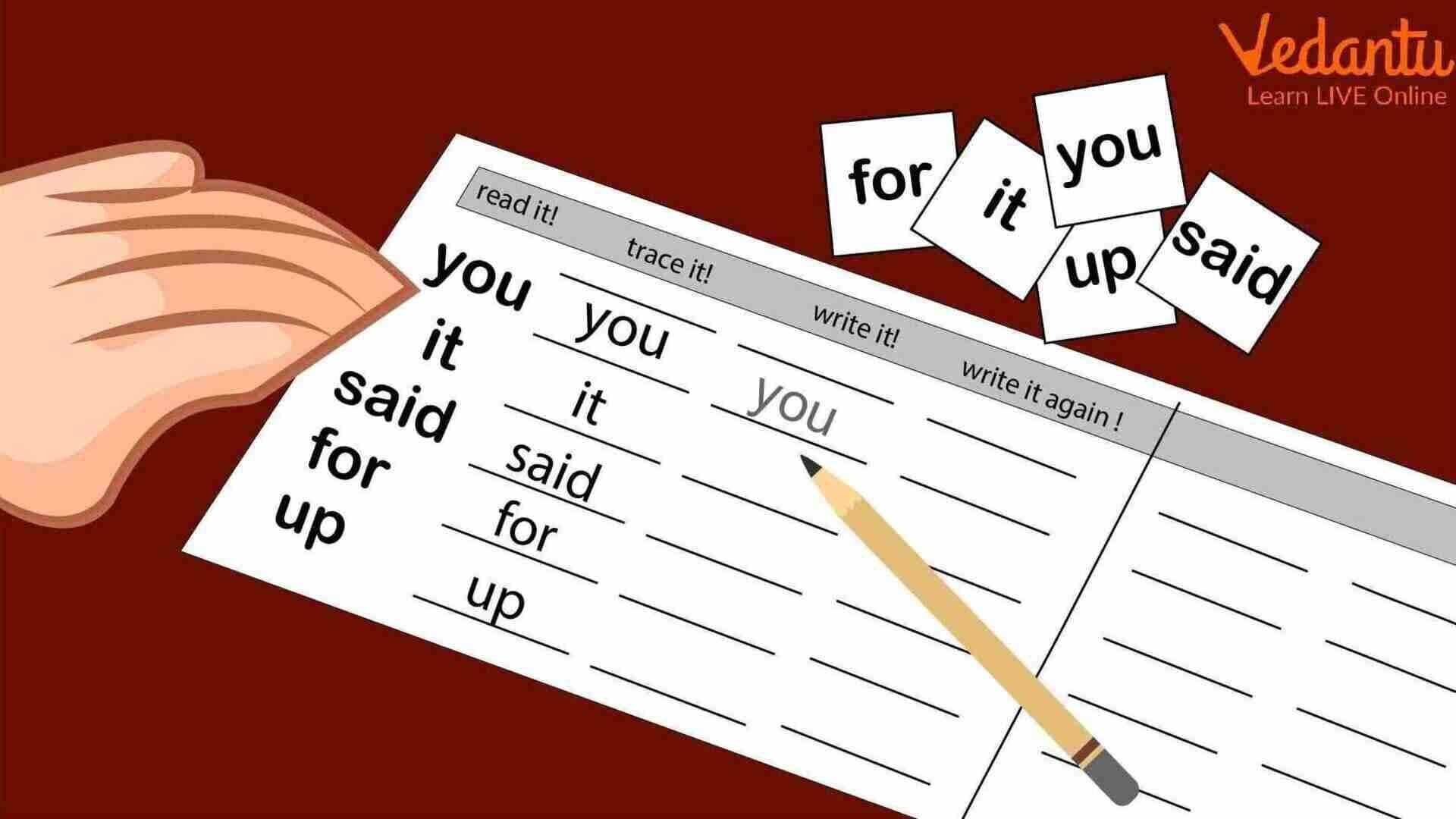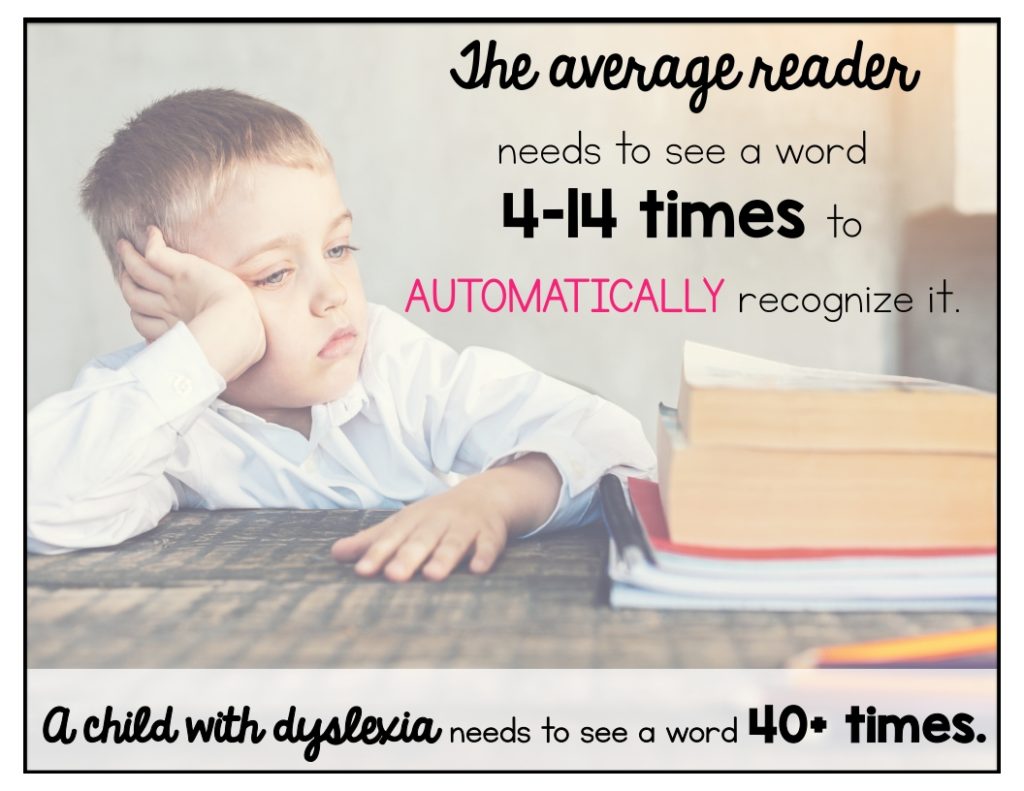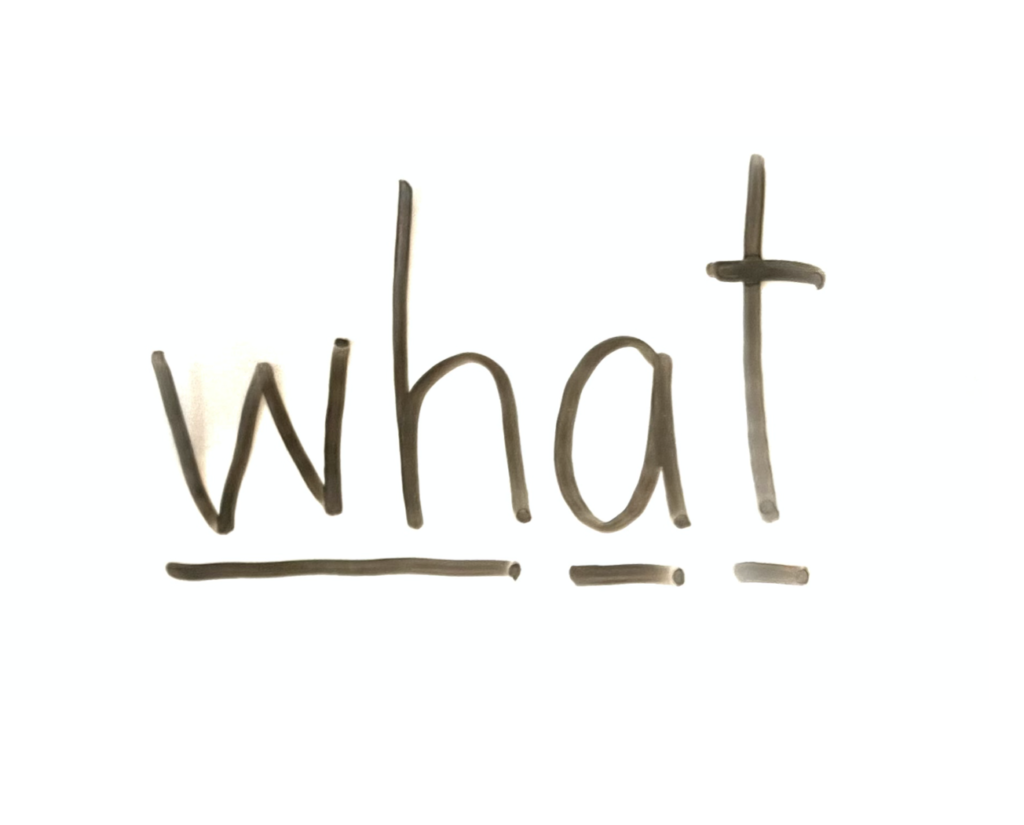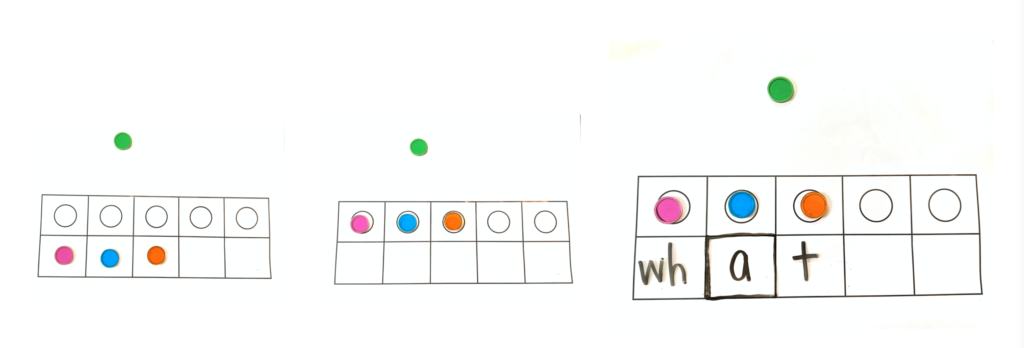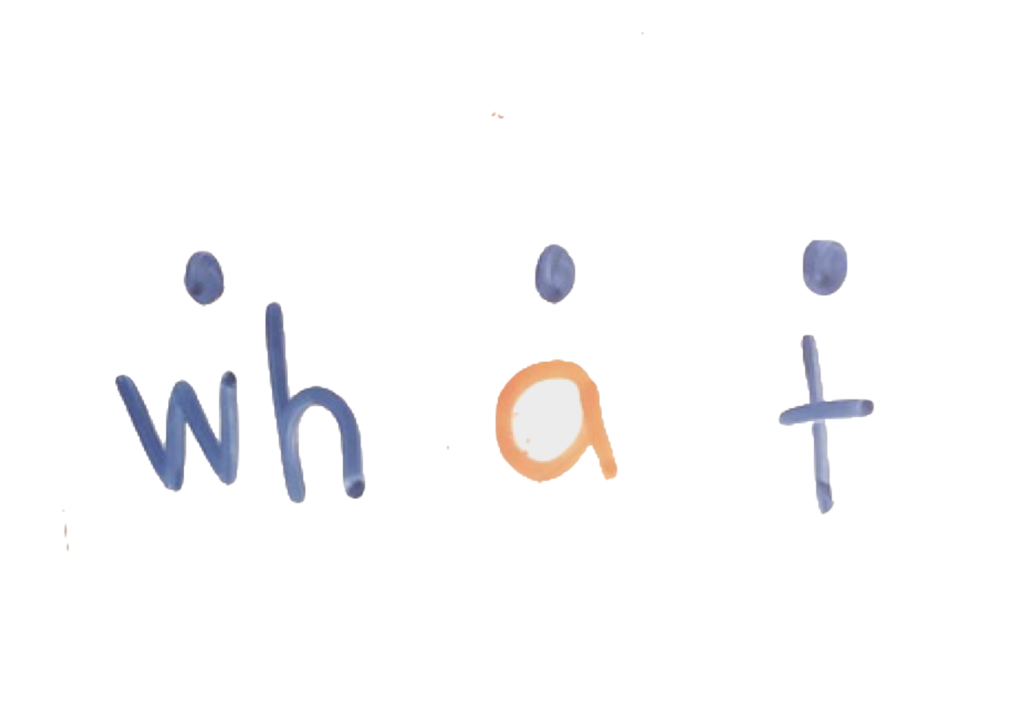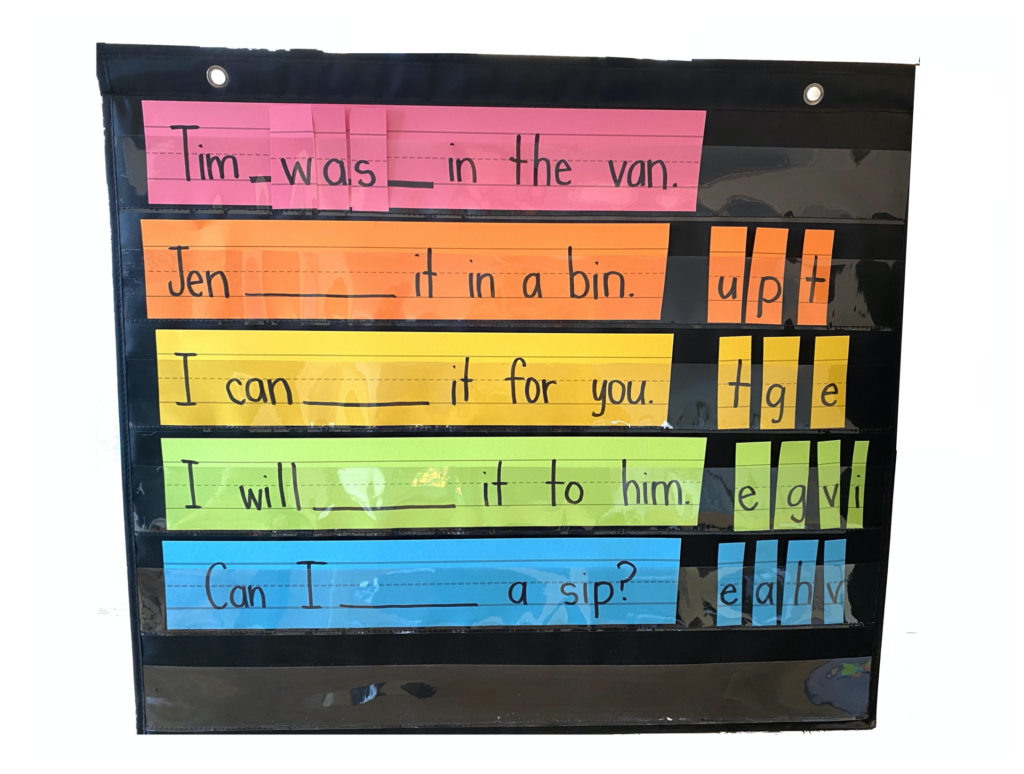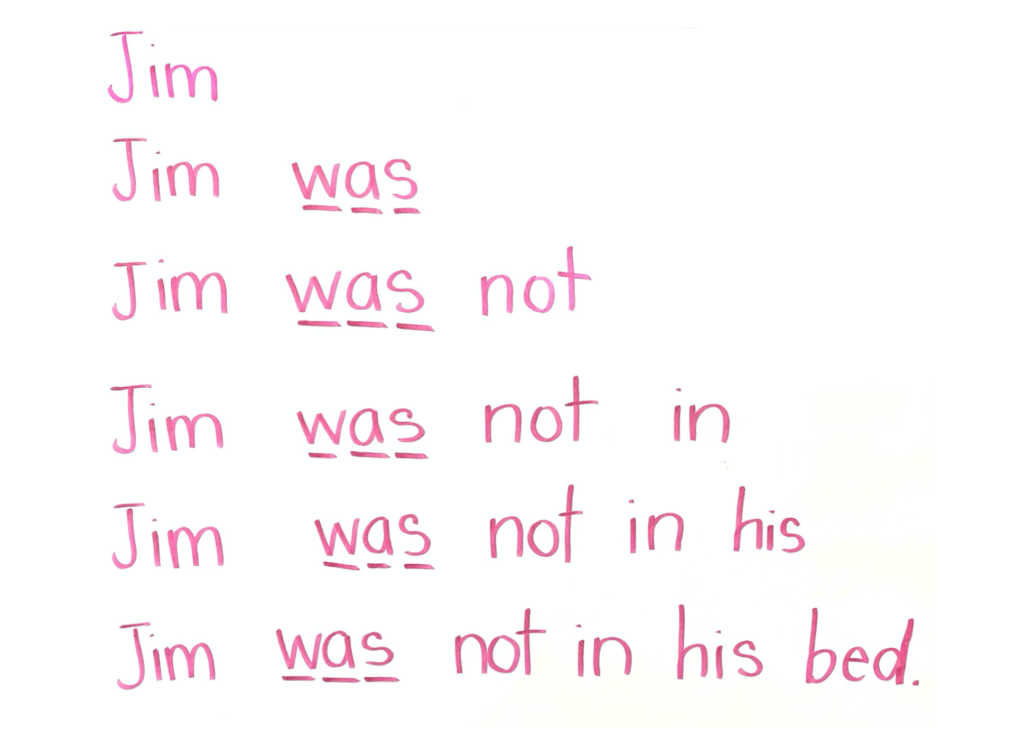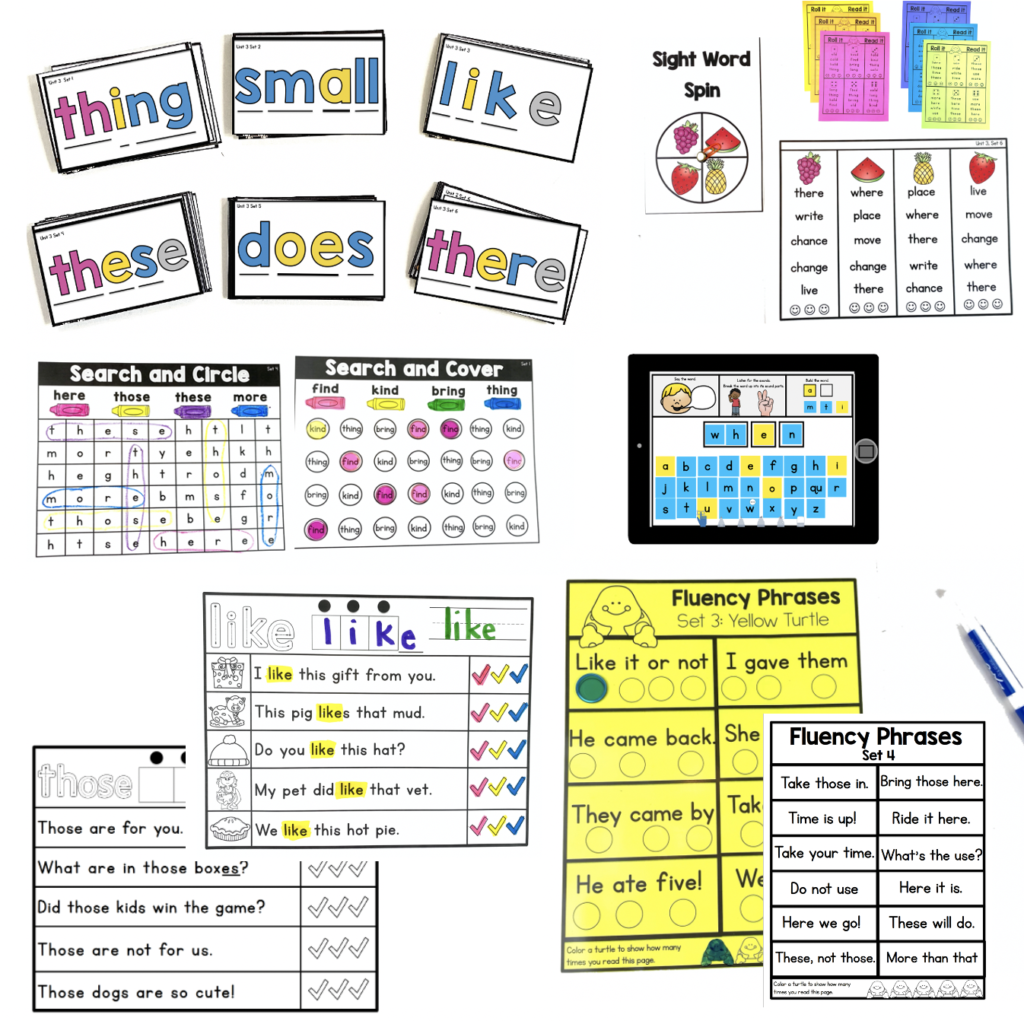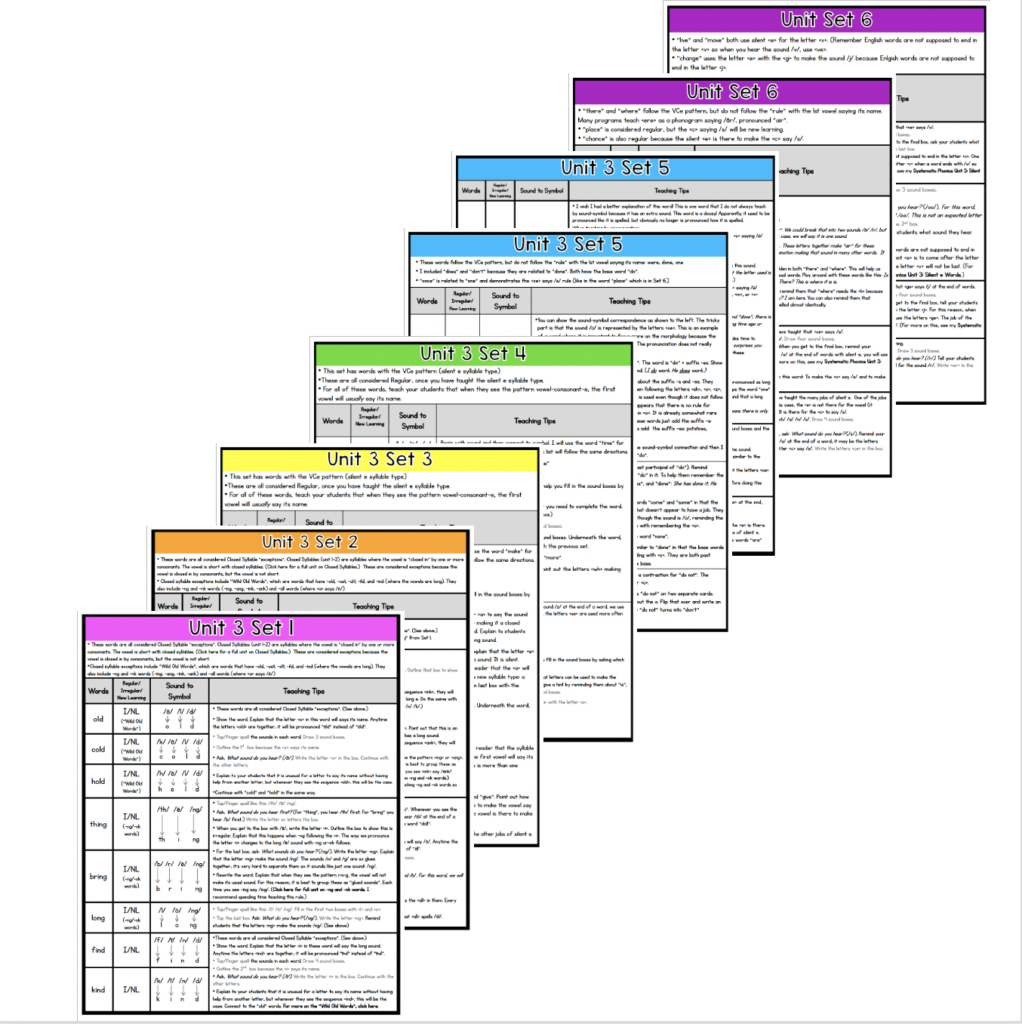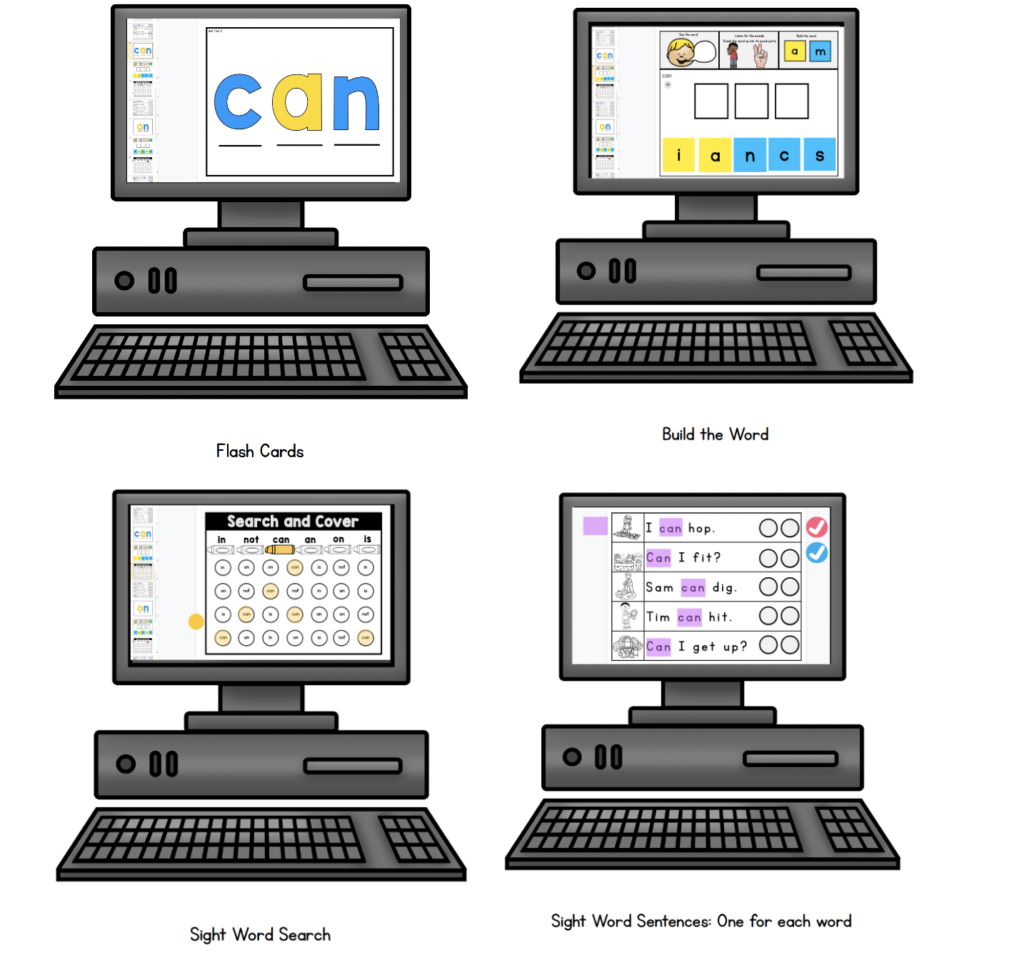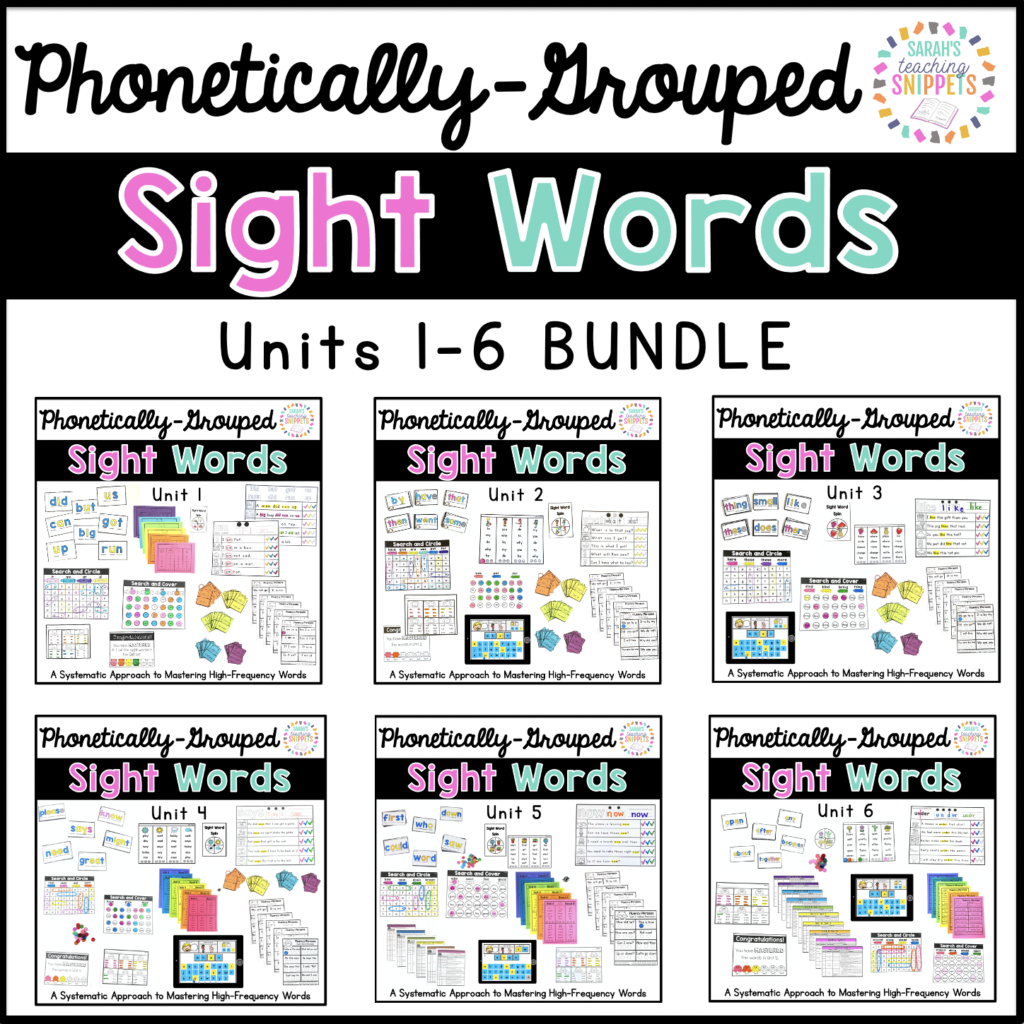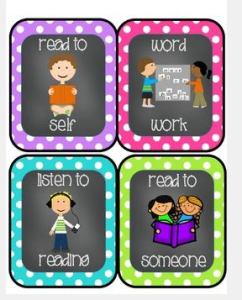When you’re a new teacher, the number of buzzwords that you have to master seems overwhelming at times. You’ve probably heard about many concepts, but you may not be entirely sure what they are or how to use them in your classroom. For example, new teacher Katy B. asks, “This seems like a really basic question, but what are sight words, and where do I find them?” No worries, Katy. We have you covered!
What’s the difference between sight words and high-frequency words?
Oftentimes we use the terms sight words and high-frequency words interchangeably. Opinions differ, but our research shows that there is a difference. High-frequency words are words that are most commonly found in written language. Although some fit standard phonetic patterns, some do not. Sight words are a subset of high-frequency words that do not fit standard phonetic patterns and are therefore not easily decoded.
We use both types of words consistently in spoken and written language, and they also appear in books, including textbooks, and stories. Once students learn to quickly recognize these words, reading comes more easily.
What are sight words and how can I teach my students to memorize them?
Sight words are words like come, does, or who that do not follow the rules of spelling or the six types of syllables. Decoding these words can be very difficult for young learners. The common practice has been to teach students to memorize these words as a whole, by sight, so that they can recognize them immediately (within three seconds) and read them without having to use decoding skills.
Can I teach sight words using the science of reading?
On the other hand, recent findings based on the science of reading suggests we can use strategies beyond rote memorization. According to the the science of reading, it is possible to sound out many sight words because they have recognizable patterns. Literacy specialist Susan Jones, a proponent of using the science of reading to teach sight words, recommends a method called phoneme-grapheme mapping where students first map out the sounds they hear in a word and then add graphemes (letters) they hear for each sound.
How else can I teach sight words?
There are many fun and engaging ways to teach sight words. Dozens of books on the subject have been published, including the much-revered Comprehensive Phonics, Spelling, and Word Study Guide by Fountas & Pinnell. Also, resources like games, manipulatives, and flash cards are readily available online and in stores. To help get you started, check out these Creative and Simple Sight Word Activities for the Classroom. Also, check out Susan Jones Teaching for three science-of-reading-based ideas and more.
Where do I find sight word lists?
Two of the most popular sources are the Dolch High Frequency Words list and the Fry High Frequency Words list.
During the 1930s and 1940s, Dr. Edward Dolch developed his word list, used for pre-K through third grade, by studying the most frequently occurring words in the children’s books of that era. The list has 200 “service words” and also 95 high-frequency nouns. The Dolch word list comprises 80 percent of the words you would find in a typical children’s book and 50 percent of the words found in writing for adults.
Dr. Edward Fry developed an expanded word list for grades 1–10 in the 1950s (updated in 1980), based on the most common words that appear in reading materials used in grades 3–9. The Fry list contains the most common 1,000 words in the English language. The Fry words include 90 percent of the words found in a typical book, newspaper, or website.
Looking for more sight word activities? Check out 20 Fun Phonics Activities and Games for Early Readers.
Want more articles like this? Be sure to sign up for our newsletters.
Last updated date: 14th Apr 2023
•
Total views: 85.2k
•
Views today: 10
When teaching kids English, you need to always start with the basics. What are the basics of learning English? Is sentence formation the basis of learning English? Well, yes. But kids also need to understand what they read in books or listen to. Of course, it does not happen overnight. But sight words are something that can come to your rescue.
Simply because if you look at the sight words examples, you can see that sight words for kids do not have any image. They are just words that kids need to recognise and remember. In simple words, sight words help kids understand the text they read.
What Is the Meaning of Sight Words?
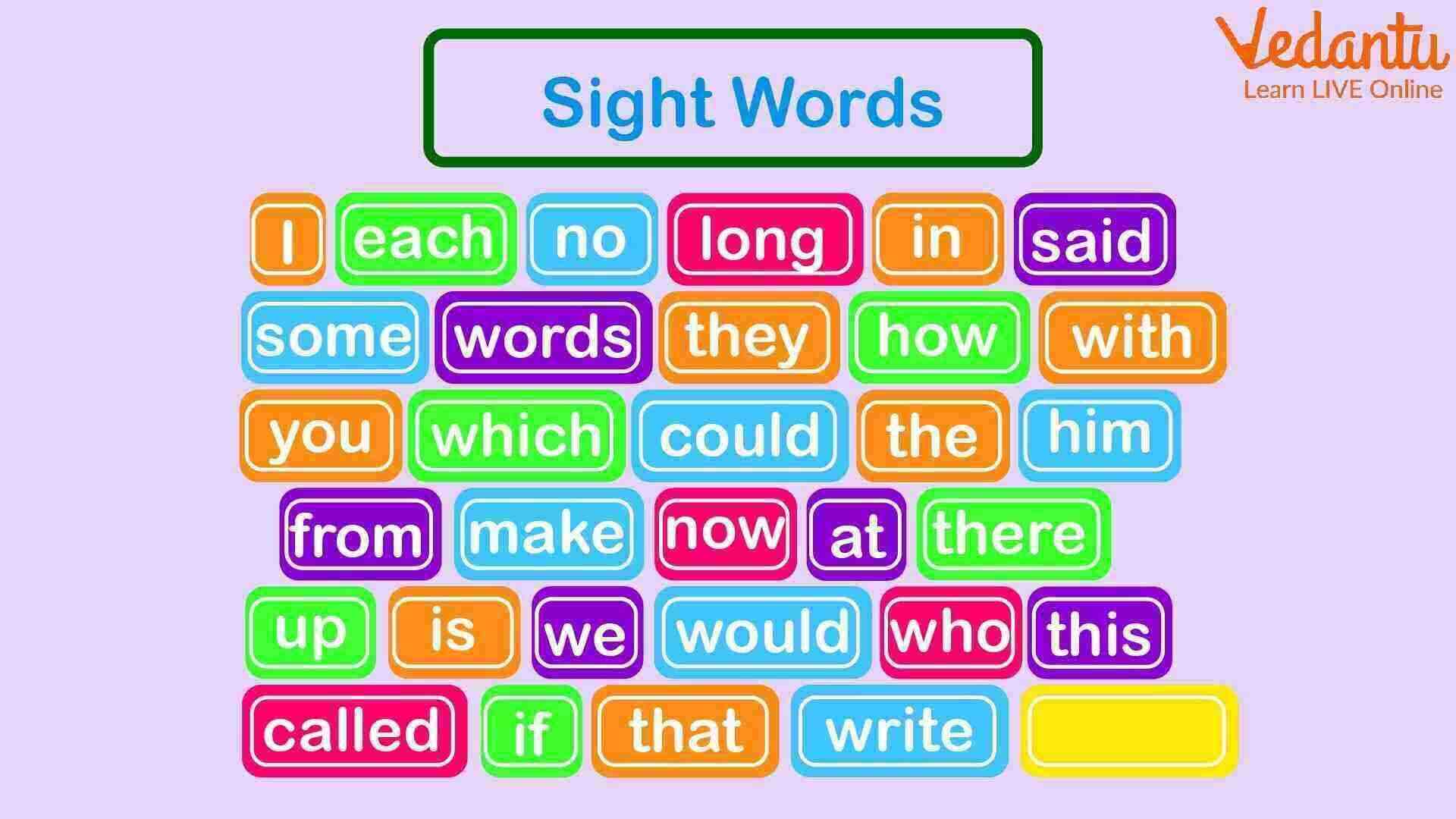
Sight words for kids
What are the sight words? To understand how sight words work, sight words’ meaning is very important. Sight words’ sentences are very common. They appear very frequently in every text. Though these words do not provide any particular image like others, they have high frequency, so readers need to memorise the words after seeing them.
For example, if you read the word ‘bright’ on a page, you can automatically get an image that talks about something clear and shiny.
So, what are sight words? The words like ‘I’, ‘and’, ‘or’, ‘a’ are the sight words. You can understand their contribution if you ask your kids to read at least a page daily. By learning the sight words, kids gain confidence in reading and understanding the sentences of an unknown text. The sight words have some characteristics, which are as follows:
-
You can see sight words’ examples very often in a text. You can see them in every line of text.
-
There is a huge sight words list, and if you follow the list, you can see that the sight words do not follow the traditional way of spelling. This means their sounds do not match up with their letters.
-
Imagine the sight words’ sentences. Try to find ‘the’, ‘or’, ‘and’ in a sentence. Can you form a concrete image of these words? No right? Because as we have said before, these words do not carry any image with them like the rest.
-
Whether you follow sight words for kids or sight words’ meaning, you can see that adjectives, common verbs, and conjunctions are commonly used as sight words. These words help convey a special meaning of the sentence despite carrying no special meaning individually.
List of Some Sight Words
There are at least 300 sight words in the English language. However, if your children are beginners, they will most likely deal with 100 sight words in whatever text they read or write.
-
A: an, are, and, about, after.
-
B: But, been.
-
C: Called, could, can.
-
D: Down, done, did.
-
F: From, form, for, first.
-
H: He, his, had, have.
-
I: In, is, it.
-
K: Know
-
L: Like
-
M: More, many, much, may, most
-
N: Not, now
-
O: Or, out, of, other
-
S: Said she
-
T: The, these, this, then, they
-
U: Up
-
W: Was, will, would, water.
-
Y: Your, you, yours.
These are some basic sight words your kids can encounter while reading something.
How to Help Kids Learn Sight Words?
Sight word examples
Though sight words are very common and easily found, if kids get a little help, they can learn the use of the words faster. Since sight words with sentences are very common, here are some tips that can help you to teach kids the words sooner.
-
The first thing you can do to teach kids how to memorise sight words is to expose them to more reading and listen to different texts daily. You can easily spend at least an hour with your kids reading something. If you keep reading them some stories daily, they can have many sight words. If you can do it multiple times every day, they are likely to hear at least 1 million or more than 1 million sight words daily.
-
You can also teach them the sight words on the roads or in stores. On roads, you can see signboards, and in the stores, you can see many boards writing about different products. You can ask them to read them repeatedly. This practice can help them learn sight words with sentences.
-
One of the best ways to teach sign words to kids is to emphasise the sentences that have sight words. When you read a story or passage to your kids, emphasise the lines and read them aloud, so they understand their meaning.
-
You can help them use their senses by playing with them with sign words. For example, you can provide some fill-in-the-blanks exercises on a page and ask them to fill the gaps. This is a great way to teach them what sight words are and why these words are so important to form a sentence.
Some Sight Words Phrases and Sentences to Help Kids Learn the Use of Sight Words
Sight Words Phrases
-
Come down here
-
My mother is there
-
A blue bear
-
Pretty please
-
Little flower girl
-
My birthday cake
-
Mountains without sun
-
Sometimes it’s late
-
Upon your word
Some Examples of Sight Words Sentences
-
He will go up the hill.
-
It was a long day.
-
I ate an egg.
-
The boat has a bell.
-
It was a long day.
Conclusion
Sight words carry a lot of weight in the English language without carrying any meaning individually. In simple words, a sentence cannot form a meaning without using sight words. You can see sight words’ presence in every sentence now and then.
That is why you must teach kids the meaning of the sight words and their uses. One of the most common ways to teach kids the uses of sight words is to read them stories, poetry and different passages. This repetition can help them learn about sight words much faster.
Автор: Горбушина Оксана Сергеевна
Организация: МБОУ «СОШ №18»
Населенный пункт: Челябинская область, г. Миасс
Обучение чтению на английском языке — достаточно сложное занятие, так как есть много слов, которые читаются не по правилам, в большинстве случаев это ставит детей любого возраста в тупик, и поэтому усложняется процесс обучения чтению.
Как следствие педагог, который обучает ребенка данному виду навыка, должен владеть не просто методикой преподавания иностранного языка, а желательно современными способами преподавания, чтобы процесс обучению чтению проходил быстро, эффективно и увлекательно для детей.
Мой педагогический опят в школе составляет 11 лет, за это время мы проходили разные курсы повышения квалификации, но, к сожалению, лично я не нашла той «изюминки», за которую хотелось зацепиться и начать использовать в своей практике. Но 2 года назад случилось чудо, я познакомилась с фонетическим подходом в обучении чтению и понятием «sight words». Если о фонетическом подходе я слышала, то о понятие « sight words » в университете и на курсах повышении квалификации не говорили, поэтому я стала изучать эту тему более подробно, чтобы понять, как знание sight words может облегчить процесс обучения чтению.
Понятие «Sight words» было введено американским писателем Едвардом Уиллиан Долч в 1930 — 1940 годах. Слово « sight » с английского переводится как «взгляд», а «words» — слова. В русском языке такого понятия не существует, но можно провести аналогию с высокочастотными словами. Так вот, sight words – это слова, которые ребенку важно запомнить, чтобы научиться читать и писать. Их нужно запоминать целиком как образ, без необходимости разбивать их на буквы. Изучение sight words помогает детям быстрее научиться читать на ранних этапах. Как правило, дети запоминают слова и при чтении не задумываются, почему буква в этом слове так читается, вследствие этого увеличивается скорость чтения. Дальше перечислены некоторые примеры sight words: I, you, she, he, one, two, this, that, have, some, come и т. д.
Теперь давайте поговорим подробнее, как мы знакомимся с этими словами на занятиях с детьми возрастом от 5 до 10 лет.
Я предпочитаю вводить sight word, когда оно встречается в контексте урока или искусственно создаю ситуацию, что бы нужное слово встретилось. Так, например, мы с детьми запоминали языковую конструкцию „She is …“, и на этом этапе я ввела sight word «she».
На доске я пишу изучаемое слово и прошу детей посмотреть сначала на доску, а затем видео, где показывается параллельно графическое написание слова и его звуковое произношение. Затем после просмотра видео дети должны сказать мне, как оно произноситься. В своей работе я использую видео с ютуб канала «Preschool Prep Company» . Каждое видео – это маленькая история о слове, которая воспринимается с удовольствием.
После того, как мы познакомились со звуковым содержанием слова, дети вырезают фигуру понравившегося им животного или фрукта из бумаги и клеят на нее печатный вариант слова. Затем с помощью скотча крепят эту картинку на тонкую шашлычную палочку и втыкают ее в коробку, где «живут» у нас все sight words. Такие веселые палочки повышают мотивацию детей и позволяют педагогу быстро повторить с детьми все изученные sight words.
На следующем уроке мы опять обращаемся к нашим коробочкам, сначала вспоминаем уже изученные слова, а потом продолжаем работу над новым словом. На втором этапе дети делают рабочий лист « worksheet », который помогает ученикам запомнить написание слова. Эти рабочие листы можно найти в интернете и распечатать. Обычно они включают в себя следующие задания: найди слово и обведи его в кружок, обведи буквы слова, раскрась буквы разными цветами, найди слово и выдели его маркером, напиши его, вырежи буквы слова и приклей их в правильном порядке. Работа с рабочим листом занимает максимум минут 10, но зато дети начинают его узнавать. Однако этого не достаточно, чтобы запомнить его окончательно.
Кроме того, периодически на занятиях мы возвращаемся к sight words и играем с ними. На листах формата А4 я печатаю по одному изучаемому слову, раскладываю листы на полу, предварительно вспомнив с детьми какое слово как читается. Задание заключается в том, что дети должны наступить на то слово, которое называет учитель. Здесь важно время от времени перемещать листы на полу, так как некоторые дети запоминают не слово, а место где лежит слово. Данная игра активная, позволяет детям подвигаться, отдохнуть и заодно выучить sight words.
И последнее, что я создала для лучшего изучения sight words – это была интерактивная игра на сайте Wordwall. Wordwall – представляет собой многофункциональный инструмент для создания как интерактивных, так и печатных материалов. Игры, созданные на этом сайте, очень удобно использовать при дистанционном обучении. Мной было создано вращающиеся колесо, которое делится на несколько разноцветных секторов. В каждом секторе написано определенное sight word. Задача детей — крутить колесо и называть то слово, на которое покажет стрелка. Ребята играют в эту игру с большим интересом.
После того, как мы проходим через все эти этапы, обычно дети без проблем узнают изученные слова и они не вызывают у них никаких трудностей на всех этапах обучения чтению и письму. Чтобы читатель мог прочувствовать и понять, как детям нравится изучать sight words, я создала презентацию, где можно проследить все этапы изучения этих « обычных необычных » слов.
Список литературы:
1. http://didaktor.ru/wordwall-zamechatelnaya-kollekciya-shablonov-didakticheskix-igr/
2. https://letterland.ru/cards/
3. https://vk.com/@english.stepbystep-sight-words-chto-eto-i-kak-s-nimi-rabotat.
Приложения:
- file1.pptx.zip.. 1,9 МБ
- file0.docx.. 20,0 КБ
Опубликовано: 17.05.2021
Having students practice their sight words is a great way for them to begin building and improving their reading fluency. I have many different sight word activities I like for my students to do. One of my literacy centers usually contains some type of sight word activity. Sometimes that might include a game, worksheet, or just simple sight word flashcards. Once I see my students mastering those sight word flashcards I like to step it up and include these sight word phrases and short sentences flashcards. These sets are so great that I thought I would share them!
Each set of flashcards is aligned to Dr. Edward Fry’s Instant Word Lists 100, 200, 300, 400, 500, and 600. I start my first graders off with set 1. Some students can continue to progress through the different sets.
Each flashcard set is color coded based on the Fry word list that it contains.
For example:
Yellow Set: 1st 100 Fry Words
Green Set: 2nd 100 Fry Words
Orange Set: 3rd 100 Fry Words
Blue Set: 4th 100 Fry Words
Pink Set: 5th 100 Fry Words
Purple Set: 6th 100 Fry Words
Each card in the set includes either a phrase or a short sentence using the words from that Fry word list. Many of the words are used multiple times in different sentences, which makes for great repeated practice.
The flashcard sets also build on each other. For example, the green set (set 2) has words from the 1st and 2nd list of Fry sight words. The orange set (set 3) has words from the 1st, 2nd, and 3rd list of sight words and so on. Which is also great for that repeated practice!
Each set of cards includes 75-120 phrases/short sentences that are aligned to each Fry sight word list, totaling 635 cards in all.
There are so many different ways you can use these sight word sets in your classroom besides just at a literacy center….
-
You can use them as whole group practice during bathroom breaks, when there is extra class time, etc.
-
At guided reading groups
-
As a partner practice activity
-
In earlier finisher tubs
-
With students that need one-on-one help and/or RTI interventions
-
….and so much more!
Place them in tubs or even hang them up in your classroom with hooks!
They are simple to put together. Simply print, laminate, cut, hole punch, and attach the cards together using a book ring.
You can grab these Sight Word Phrases and Short Sentences from my TpT store by clicking HERE!
Изучать английский язык с детьми может быть полезным и для вас. Несмотря на то что юные ученики предпочитают избегать задания по письму и чтению, практика грамматики и лексики им все же необходима. В этом помогут sight words.
Sight words — это часто употребляемые английские слова, которые можно легко запомнить визуально (“sight” переводится как “взгляд”). Даже если ваш ребенок только начал изучать английский алфавит, вы можете вводить sight words. Дети запоминают эти слова как картинки. Они строят ассоциации и в дальнейшем могут узнавать sight words в предложениях.
Многие британские и американские программы предлагают ряд слов для каждого уровня. Например, в детском саду и начальной школе студенты изучают следующие sight words: a, and away, blue, two, up, on и т.д. С переходом в другие классы повышается сложность слов.
Главная цель изучения sight words — умение быстро находить их в тексте и слышать в речи. Давайте посмотрим на возможные техники запоминания этих слов.
Песни
Неважно в каком возрасте ваш ребенок начал изучение английского языка, внедрение образовательных песен всегда будет полезным. На YouTube каналах существует множество каналов по изучению и практики sight words. Например: Heidisongs, Jack Hartmann, Little Fox.
Рисование
Если ваш ребенок любит рисовать, то вы можете превратить его урок в увлекательное занятие. В сети есть множество раскрасок с sight words. Не упустите возможность повторить цвета на английском, пока выбираете палетку для будущего шедевра. Набрав определенное количество новых слов, вы также можете организовать выставку работ, при этом повторяя произношение и значение каждого слова.
Конструктор из слов
В зависимости от уровня студента вы можете строить слова по слогам или предложения по словам. Подготовьте карточки с изученными ранее словами, включая новые sight words. Попросите детей помочь вам раскрасить их. После чего разрежьте слово на слоги или по буквам. Перемешайте вырезанные пазлы и разложите их на столе по группам. Для совсем маленьких студентов лучше предложить образец слова, по которому они соберут ваш “конструктор”. Для детей постарше можно использовать аудио сопровождение или сохранить слова для составления предложений по этой же технике.
Английскую версию статьи вы найдете здесь.
Оставить комментарий
Для комментирования необходимо войти через Вконтакте
From Wikipedia, the free encyclopedia
High frequency sight words (also known simply as sight words) are commonly used words that young children are encouraged to memorize as a whole by sight, so that they can automatically recognize these words in print without having to use any strategies to decode.[1] Sight words were introduced after whole language (a similar method) fell out of favor with the education establishment.[2]
The term sight words is often confused with sight vocabulary, which is defined as each person’s own vocabulary that the person recognizes from memory without the need to decode for understanding.[3][1]
However, some researchers say that two of the most significant problems with sight words are: (1) memorizing sight words is labour intensive, requiring on average about 35 trials per word,[4] and (2) teachers who withhold phonics instruction and instead rely on teaching sight words are making it harder for children to «gain basic word-recognition skills» that are critically needed by the end of grade three and can be used over a lifetime of reading.[5]
Rationale[edit]
Sight words account for a large percentage (up to 75%) of the words used in beginning children’s print materials.[6][7] The advantage for children being able to recognize sight words automatically is that a beginning reader will be able to identify the majority of words in a beginning text before they even attempt to read it; therefore, allowing the child to concentrate on meaning and comprehension as they read without having to stop and decode every single word.[6] Advocates of whole-word instruction believe that being able to recognize a large number of sight words gives students a better start to learning to read.
Recognizing sight words automatically is said to be advantageous for beginning readers because many of these words have unusual spelling patterns, cannot be sounded out using basic phonics knowledge and cannot be represented using pictures.[8] For example, the word «was» does not follow a usual spelling pattern, as the middle letter «a» makes an /ɒ~ʌ/ sound and the final letter «s» makes a /z/ sound, nor can the word be associated with a picture clue since it denotes an abstract state (existence). Another example, is the word «said», it breaks the phonetic rule of ai normally makes the long a sound, ay. In this word it makes the short e sound of eh.[9] The word «said» is pronounced as /s/ /e/ /d/. The word «has» also breaks the phonetic rule of s normally making the sss sound, in this word the s makes the z sound, /z/.» The word is then pronounced /h/ /a/ /z/.[9]
However, a 2017 study in England compared teaching with phonics vs. teaching whole written words and concluded that phonics is more effective, saying «our findings suggest that interventions aiming to improve the accuracy of reading aloud and/or comprehension in the early stages of learning should focus on the systematicities present in print-to-sound relationships, rather than attempting to teach direct access to the meanings of whole written words».[10]
Most advocates of sight-words believe children should memorize the words. However, some educators say a more efficient method is to teach them by using an explicit phonics approach, perhaps by using a tool such as Elkonin boxes. As a result, the words form part of the students sight vocabulary, are readily accessible and aid in learning other words containing similar sounds.[11][12]
Other phonics advocates, such as the Common Core State Standards Initiative (CCSSI-USA), the Departments of Education in England, and the State of Victoria in Australia, recommend that teachers first begin by teaching children the frequent sounds and the simple spellings, then introduce the less frequent sounds and more complex spellings later (e.g. the sounds /s/ and /t/ before /v/ and /w/; and the spellings cake before eight and cat before duck).[13][14][15][16] The following are samples of the lists that are available on the CCSSI-USA site:[17]
| Phoneme | Sample only — Word Examples (Consonants) (CCSSI-USA) | Common Graphemes (Spellings) |
|---|---|---|
| /m/ | mitt, comb, hymn | m, mb, mn |
| /t/ | tickle, mitt, sipped | t, tt, ed |
| /n/ | nice, knight, gnat | n, kn, gn |
| /k/ | cup, kite, duck, chorus, folk, quiet | k, c, ck, ch, lk, q |
| /f/ | fluff, sphere, tough, calf | f, ff, gh, ph, lf |
| /s/ | sit, pass, science, psychic | s, ss, sc, ps |
| /z/ | zoo, jazz, nose, as, xylophone | z, zz, se, s, x |
| /sh/ | shoe, mission, sure, charade, precious, notion, mission, special | sh, ss, s, ch, sc, ti, si, ci |
| /zh/ | measure, azure | s, z |
| /r/ | reach, wrap, her, fur, stir | r, wr, er/ur/ir |
| /h/ | house, whole | h, wh |
| Phoneme | Sample only — Word Examples (Vowels) (CCSSI-USA) | Common Graphemes (Spellings) |
|---|---|---|
| /ā/ | make, rain, play, great, baby, eight, vein, they | a_e, ai, ay, ea, -y, eigh, ei, ey |
| /ē/ | see, these, me, eat, key, happy, chief, either | ee, e_e, -e, ea, ey, -y, ie, ei |
| /ī/ | time, pie, cry, right, rifle | i_e, ie, -y, igh, -I |
| /ō/ | vote, boat, toe, snow, open | o_e, oa, oe, ow, o- |
| /ū/ | use, few, cute | u, ew, u_e |
| /ă/ | cat | a |
| /ĕ/ | bed, breath | e, ea |
| /ĭ/ | sit, gym | i, y |
| /ŏ/ | fox, swap, palm | o, (w)a, al |
| /ŭ/ | cup, cover, flood, tough | u, o, oo, ou |
| /aw/ | saw, pause, call, water, bought | aw, au, al, (w)a, ough |
| /er/ | her, fur, sir | er, ur, ir |
Word lists[edit]
A number of sight word lists have been compiled and published; among the most popular are the Dolch sight words[18] (first published in 1936) and the 1000 Instant Word list prepared in 1979 by Edward Fry, professor of Education and Director of the Reading Center at Rutgers University and Loyola University in Los Angeles.[19][20][21][22] Many commercial products are also available. These lists have similar attributes, as they all aim to divide words into levels which are prioritized and introduced to children according to frequency of appearance in beginning readers’ texts. Although many of the lists have overlapping content, the order of frequency of sight words varies and can be disputed, as they depend on contexts such as geographical location, empirical data, samples used, and year of publication.[23]
Criticism[edit]
Research shows that the alphabetic principle is seen as «the primary driver» of development of all aspects of printed word recognition including phonic rules and sight vocabulary.»[24] In addition, the use of sight words as a reading instructional strategy is not consistent with the dual route theory as it involves out-of-context memorization rather than the development of phonological skills.[25] Instead, it is suggested that children first learn to identify individual letter-sound correspondences before blending and segmenting letter combinations.[26][27]
Proponents of systematic phonics and synthetic phonics argue that children must first learn to associate the sounds of their language with the letter(s) that are used to represent them, and then to blends those sounds into words, and that children should never memorize words as visual designs.[28] Using sight words as a method of teaching reading in English is seen as being at odds with the alphabetic principle and treating English as though it was a logographic language (e.g. Chinese or Japanese).[29]
Some notable researchers have clearly stated their disapproval of whole language and whole-word teaching. In his 2009 book, Reading in the brain, French cognitive neuroscientist Stanislas Dehaene wrote, «cognitive psychology directly refutes any notion of teaching via a ‘global’ or ‘whole language’ method.» He goes on to talk about «the myth of whole-word reading», saying it has been refuted by recent experiments. «We do not recognize a printed word through a holistic grasping of its contours, because our brain breaks it down into letters and graphemes.»[30] Another cognitive neuroscientist, Mark Seidenberg, says that learning to sound-out atypical words such as have (/h/-/a/-/v/) helps the student to read other words such as had, has, having, hive, haven’t, etc. because of the sounds they have in common.[31]
See also[edit]
- Dolch word list
- Dual-route hypothesis to reading aloud
- Fry readability formula
- Learning to read
- Literacy
- Most common words in English
- Phonics
- Reading comprehension
- Reading education in the United States
- Reading (process)
- Subvocalization
- Teaching reading: whole language and phonics
- Whole language
- Writing system
References[edit]
- ^ a b «What Are Sight Words?». WeAreTeachers. 2018-04-25. Retrieved 2018-11-30.
- ^ Ravitch, Diane. (2007). EdSpeak: A Glossary of Education Terms, Phrases, Buzzwords, and Jargon. Alexandria, VA: Association for Supervision & Curriculum Development, ISBN 1416605754.
- ^ Rapp, S. (1999-09-29). Recognizing words on sight; activity. The Baltimore Sun
- ^ Murray, Bruce; McIlwain, Jane (2019). «How do beginners learn to read irregular words as sight words». Journal of Research in Reading. 42 (1): 123–136. doi:10.1111/1467-9817.12250. ISSN 0141-0423. S2CID 150055551.
- ^ Seidenberg, Mark (2017). Language at the speed of sight. New York, NY: Basic Books. p. 147. ISBN 978-1-5416-1715-5.
- ^ a b Kear, D. J., & Gladhart, M. A. (1983). «Comparative Study to Identify High-Frequency Words in Printed Materials». Perceptual and Motor Skills. 57 (3): 807–810. doi:10.2466/pms.1983.57.3.807. S2CID 144675331.
{{cite journal}}: CS1 maint: multiple names: authors list (link) - ^ «Teaching Sight Words as a Part of Comprehensive Reading Instruction, Iowa reading research centre, 2018-06-12».
- ^ «Phonological Ability», The SAGE Encyclopedia of Contemporary Early Childhood Education, SAGE Publications, Inc, 2016, doi:10.4135/9781483340333.n296, ISBN 9781483340357
- ^ a b «Sight Words». www.thephonicspage.org. Retrieved 2018-11-30.
- ^ Taylor, J. S. H.; Davis, Matthew H.; Rastle, Kathleen (2017). «Comparing and Validating Methods of Reading Instruction Using Behavioural and Neural Findings in an Artificial Orthography» (PDF). Journal of Experimental Psychology: General. Journal of Experimental Psychology: General, volume 146, No. 6, 826–858. 146 (6): 826–858. doi:10.1037/xge0000301. PMC 5458780. PMID 28425742.
- ^ «Sight Words: An Evidence-Based Literacy Strategy, Understood.org».
- ^ «A New Model for Teaching High-Frequency Words, reading rockets.org». 6 June 2019.
- ^ «Complete report — National Reading Panel, England» (PDF).
- ^ «Sample phonics lessons, The State Government of Victoria».
- ^ «Foundation skills, The State Government of Victoria, AU».
- ^ «English Appendix 1: Spelling, Government of England» (PDF).
- ^ «Common Core Standards, Appendix A, USA» (PDF).
- ^ «Dolch Words 220, Utah Education Network in partnership with the Utah State Board of Education and Utah System of Higher Education» (PDF).
- ^ Edward Fry (1979). 1000 Instant Words: The Most Common Words for Teaching Reading, Writing, and Spelling. ISBN 0809208806.
- ^ «McGraw-Hill Education Acknowledges Enduring Contributions of Reading and Language Arts Scholar, Author and Innovator Ed Fry, McGraw-Hill Education, Sep 15, 2010».
- ^ «Edward B. Fry, PH.D, Published in Los Angeles Times on Sep. 12, 2010». Legacy.com.
- ^ «Fry Instant Words, UTAH EDUCATION NETWORK».
- ^ Otto, W. & cester, R. (1972). «Sight words for beginning readers». The Journal of Educational Research. 65 (10): 435–443. doi:10.1080/00220671.1972.10884372. JSTOR /27536333.
- ^ «Independent Review of the Primary Curriculum: Final Report, page 87» (PDF).
- ^ Ehri, Linnea C. (2017). «Reconceptualizing the Development of Sight Word Reading and Its Relationship to Recoding». Reading Acquisition. London: Routledge. pp. 107–143. ISBN 9781351236898.
- ^ Literacy teaching guide : phonics. New South Wales. Department of Education and Training. [Sydney, N.S.W.]: New South Wales Dept. of Education and Training. 2009. ISBN 9780731386093. OCLC 590631697.
{{cite book}}: CS1 maint: others (link) - ^ Findings and Determinations of the National Reading Panel by Topic Areas
- ^ McGuinness, Diane (1997). Why Our Children Can’t Read. New York, NY: The Free Press. ISBN 0684831619.
- ^ Gatto, John Taylor (2006). «Eyless in Gaza». The Underground History of American Education. Oxford, NY: The Oxford Village Press. pp. 70–72. ISBN 0945700040.
- ^ Stanislas Dehaene (2010-10-26). Reading in the brain. Penquin Books. pp. 222–228. ISBN 9780143118053.
- ^ Seidenberg, Mark (2017). Language at the speed of light. pp. 143–144=author=Mark Seidenberg. ISBN 9780465080656.
When you hear the words “sight word instruction”, what do you think of? I can honestly say that my idea of what “sight word instruction” means and looks like has drastically changed over the years. In fact, my definition of “sight words” has even changed.
Often the term is used interchangeably to mean a few things: high-frequency words, irregular words, and words that students recognize on sight.
I used to think of sight words as words that couldn’t be sounded out and needed to be memorized. I also thought of them as words that needed to be memorized as a whole. I used the flash card method mostly, with the belief that if my students saw these words enough times, they would memorize them. This turned out to be true for some of my students. However, it certainly was not the case with many of my students. I started to look into why. I eventually learned that the research points to more effective methods of teaching “sight words”.
What are Sight Words?
Now I define sight words as words that can be read instantly and effortlessly (“on sight”).
- High-frequency words are words that are the most occurring in print. Because they are words that our students will most likely encounter in a text, we often work hard to help these become “sight words”.
- This includes words that are fully decodable and words that have some irregularities.
- Technically, the goal is to make every word a “sight word” but in the beginning, it is helpful for students to know these particular high-frequency words since they account for 75% of words in print.
- The fancy word for “sight word” is orthographic lexicon, or the words that a reader can read automatically and without any effort.
There are two main lists that most teachers pull from: the Dolch and Fry Lists, that include the most frequently occurring words in children’s texts. Both of these lists were originally created to use the “look-say” method (essentially whole language approach).
We now have more research to draw from that tells us reading outcomes are stronger when beginning readers are taught to decode words using sound-symbol associations, rather than rote memorization. That goes for all words, including regular and irregular high-frequency words.
Why is Teaching Sight Words Important?
Knowing that these high-frequency words appear more often in children’s texts means we should spend a little more time on these words so that our students can read them automatically and with little effort. Helping these high frequency words become “sight words” will begin to improve their fluency because automatic word recognition is the first step toward fluency (followed by developing prosody, rate, expressing, and appropriate phrasing).
Even your average beginning reader needs to be exposed to a word several times in order to read it with automaticity. Students with dyslexia need SEVERAL more exposures to those words. We need to provide them with those opportunities to practice these words.
However, by second grade on, your typically developing readers are able to store a new word permanently in only one to four exposures (Bowey & Miller, 2007). The exact number for readers with dyslexia is not known, although I can tell from experience, it’s a lot more than that and it varies from student to student.
Some Facts about Sight Words
Another thing we need to get out of the way is the idea that most “sight words” (high-frequency words) are all irregular. I’m going to throw some facts out there:
- Many high-frequency words are decodable.
- The majority of irregular words actually only have only one irregular letter-sound relationship.
- Even though these words are irregular, they are still stored in our long-term memory using the same orthographic mapping process as regular words.
- Most of these irregular words have a history (etymology) and relatives that actually do explain the spelling.
How Do We Learn Sight Words?
How do our brains process and permanently store words into our sight memory? Orthographic mapping! According to David Kilpatrick, new readers map the phonemes (sounds) of words (that they already have in their phonological memory) to the sequence of the letters they see on the page. Once a word has been adequately mapped, it is there for quick, effortless retrieval.
Ortho means straight (correct, in order, sequence) and graph means writing. Together that makes correct writing.
We form connections between the pronunciation of a word (with the individual sounds) and the order of the printed letters. We are connecting sounds to sequence of letters. This connection is called “mapping”. Orthographic mapping allows our brains to permanently store words, so we can retrieve them automatically.
We need three things for this to happen:
- Automatic sound-symbol awareness
- Phoneme awareness
- Word study: helping students see the connections between letters and sounds
Here’s a tidbit I just learned: According to David Kilpatrick’s book Essentials of Assessing, Preventing, and Overcoming Reading Difficulties, we actually do not memorize sight words using our visual memory. We use vision for input but not for storage. Instead, storage is orthographic, phonological (sound), and semantic (meaning). Mind blown, right? That means new words are not simply memorized just by seeing it over and over.
For more about orthographic mapping, click here.
Another study out of Stanford found that “beginning readers who focus on letter-sound relationships increase activity in the area of the brain best wired for reading. In other words, to develop reading skills, teaching students to sound out C-A-T sparks more optimal brain circuitry than instructing them to memorize the word cat.” This also debunks the idea that high-frequency words should be learned using the “look-see-learn” whole language method.
How to Teach Sight Words
Now that I have a better understanding of how our brains learn new words, I’ve made some changes to how I approach sight words. Now, the first thing I do is introduce the word orally and explicitly teach the sound-symbol connections.
Step 1: Match the Sounds to the Correct Letters
Here are the steps to take;
- Introduce the word and show the student:
- Say the word.
- Write the word and show your students.
- Use your finger to tap under the letters as you break the word up into its sound parts. (For the word “what”, you would underline with your finger (or actual underline as shown below): <wh> as you say /w/, underline <a> as you say /u/ and <t> as you say /t/. Erase the word or move it away.
- Repeat the word
- Segment the word into its individual sounds.
- Draw dots, sound boxes, or use bingo chips to represent those sounds.
- Students will tap the sound boxes or slide the bingo chips as they say the sounds. For example: /w/ /u/ /t/.
- Discuss what letters you expect to see representing each sound.
- If there is a word that has an irregular sound-symbol relationship, I often outline that box in another color if I’m using sound boxes or use another color for the dot if I’m just making dots.
- Show the word you had written in the first step. Underline with your finger again the letters as you say each sound. Point out the unexpected sounds.
- Have your students write the letters that go with each sound in the sound boxes or above the dots.
Click HERE to download the printable below.
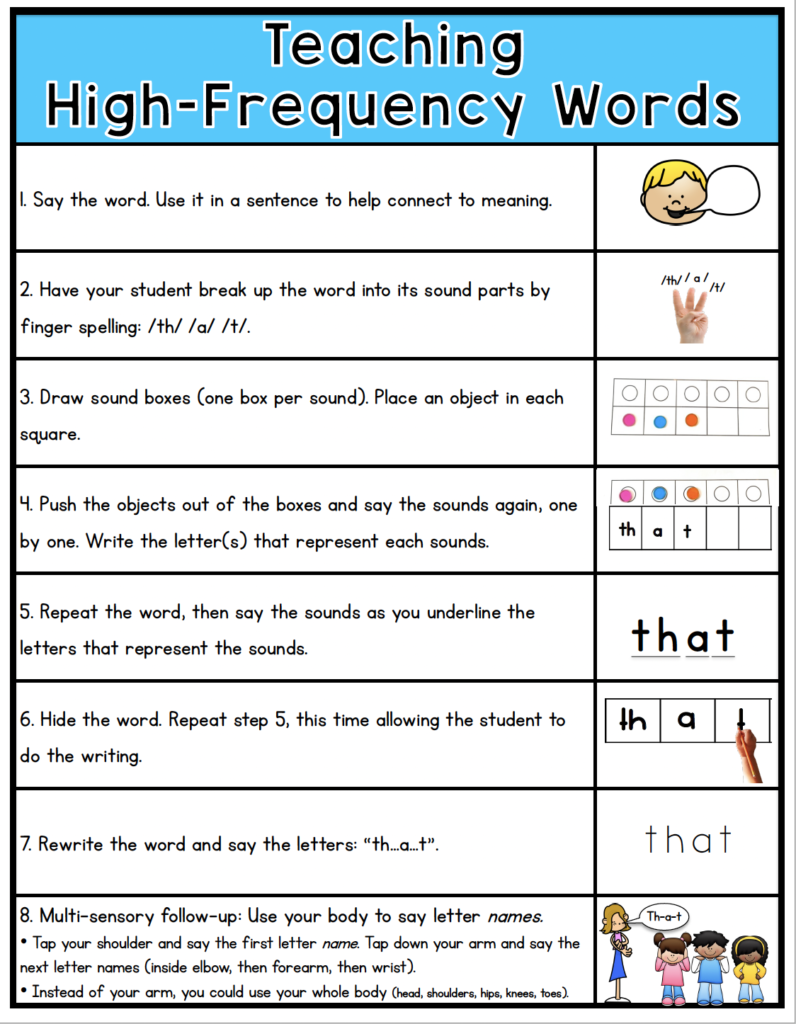
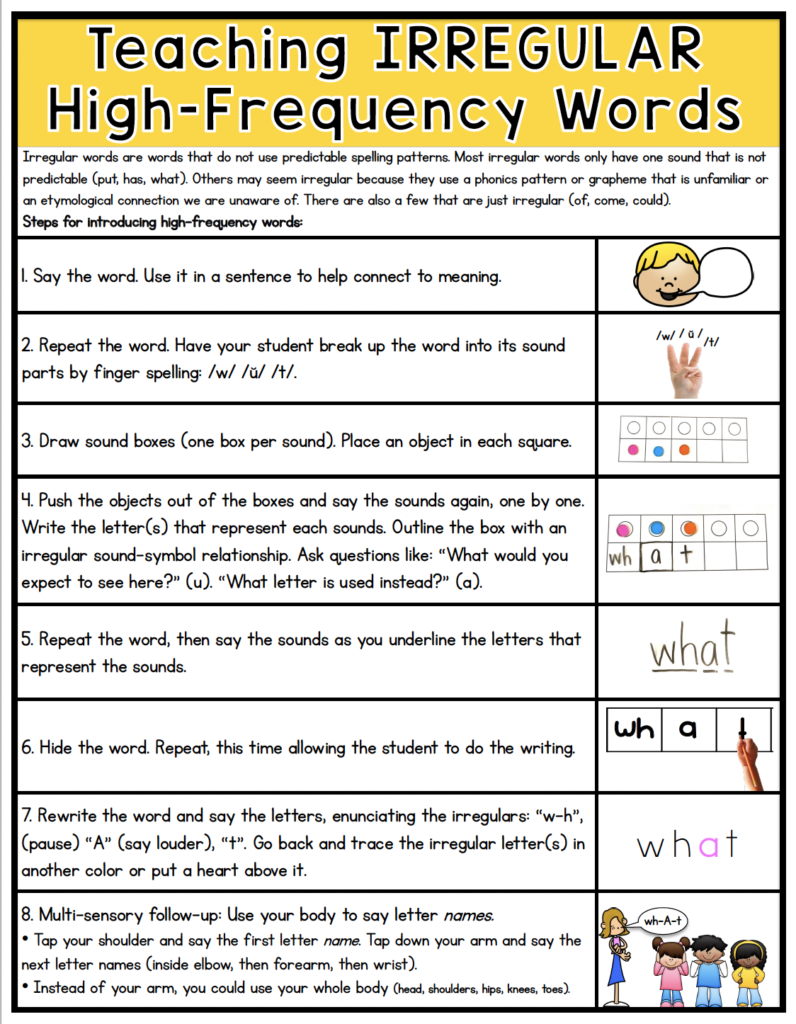
Highlight the “Irregular” or Unexpected Sound
This is another tip that I find very helpful. Somehow highlight the unexpected letter-sound relationship.
For example: Connect the sound /w/ with <wh>, /u/ with <a>, and /t/ with <t>. Then highlight, underline, or use another color for the letter <a>. You could also underline that letter.
Update: I have now learned of a method called “heart words” where people put a heart over the irregular sound-symbol relationship. When I originally wrote this post years ago, I had never heard of heart words, but I do love this idea!
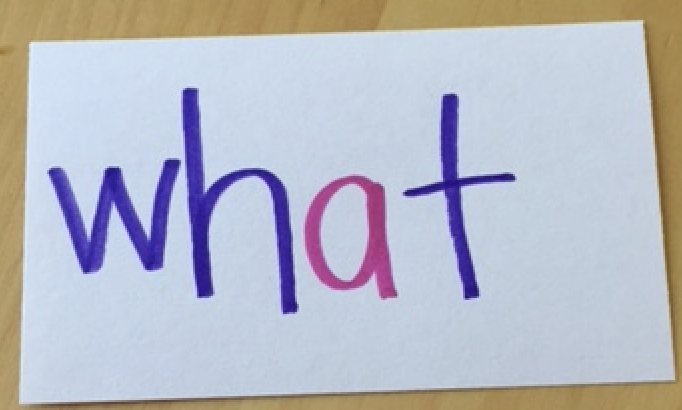
Show your students the word with the highlighted “odd” or unexpected letter(s). Practice spelling the word as you did earlier (in the above tip.) This time enunciate the odd letter(s) vocally. “Wh-A-t” You could enunciate it with a louder voice or with an accent or with a funny voice- anything to get that letter to stick! Notice how I also said wh together. That is intentional because I want them to group those two letters since they are one grapheme representing the sound /w/.
A lot of times, there may actually be a reason for the unexpected sound-symbol connection. In this case, teach your student why that letter is used.
- For example, the word give and have end in the letter e. This makes our students think that it is not fully decodable. But actually, there is a reason for that e. Did you know an English word should not end in v? So that silent e has a purpose, just not one that they are used to. (The e is there to make sure the v isn’t the last letter.) Click here for more about the “rules” of spelling.
- In the word, around and about, the a says /uh/ which makes it trickier. Well, that is also a phonic thing called Schwa.
Step 2: Make it Multi-Sensory
This is nothing new but it’s always worth saying. Students need to see it, say it, write it, feel it, and hear it.
- Have students say the letters in the word as they trace the letters.
- Repeat. Say the word again.
- Have the student write the letters in the air AND on the table or a bumpy surface, saying the letters as they trace, repeating the whole word when they are done.
- After seeing and tracing the word, guide your student to try to take a “snapshot” of this word in their brain: Look at the word, say the letters, then close your eyes and try to see the word repeating the letters. I try to group letters together that go with sounds. For example, wh-A-t. I say the <wh> together because they make one sound together. I say the <a> louder because it is irregular.
To spice it up, use sand and/or add glue to the flashcards to give them a bumpier feel. I often use these foam sheets with different textures for students to trace on. If you don’t have all of these extra things, that is okay. Truly, multi-sensory just means uses multiple senses. That means multisensory can just mean you say, see it, hear it, and write it.
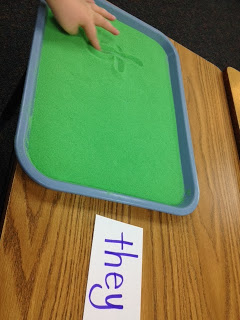
A popular method that Orton-Gillingham tutors use is the Arm Tap.
- Begin at the shoulder.
- Say the first letters as you tap your right shoulder with your left hand.
- Move down your arm and say the other letters as you tap down your arm.
- Once you’ve said all the letters, repeat the word as you slide your hand from your shoulder to your wrist.
For example, the word what would go like this: “w-h” (tap shoulder), “a” (say louder since it’s an oddball and tap inside elbow), and “t” (tap wrist). I’m not sure if there is actual research to back this method up, but it is another way to practice the word and it’s always nice to get kids moving!
Step 3: Repeat, Repeat, Repeat
This one is obvious, I know! Remember how a child with dyslexia needs to see a word 40+ times? That’s a lot of exposures for that little one. My challenge is always, how do I do this without boring my kids to tears?! I think playing games is a great way to get that repetition.
Below are some easy games to play (with free editable templates):
Spin and Read: You can make your own spinner using a metal fastener. Write the words you are working on in the spinner. Make a chart like the one shown next to the spinner. Write each word in the first column. After you spin, read the word you land on. Then write that word in the second column in the correct row.
Roll a Word: Make a chart like the one shown below (with the dice). Instead of the dice that are shown, simply write 1-6. Write a sight word in each box. Roll the die. Read the words under the number that you landed on.
Tic Tac Toe: Write your sight words on a stack of index cards. Draw a card. Read the word. Write the word on the Tic-Tac-Toe board. (Each player will have a different color marker.) The next player does the same. Continue as you would with Tic-Tac-Toe, trying to be the first to get three in a row.
Word-O: Draw a 3×3 or 4×4 grid. Ahead of time, each player writes the same sight words on their own board in different spaces. Write those same words on index cards. Draw an index card. Read the word. Then cross out that word on your board. Continue until someone gets three/four in a row or black out.
As fun as games are, it’s also so impactful to give them plenty of practice to write the words again using the sound boxes, making the connection from sound to symbol and reviewing any irregular part.
Using Flash Cards Effectively
After we’ve done phoneme-grapheme mapping, then I bring out the flashcards for students to practice. One common mistake I see/hear about a lot is not letting kids sound out the word when they are using flash cards. Teachers will say, “If they don’t know the word automatically, I tell them the word and then skip it and come back to it because they need to know it automatically.” I was also one of these teachers.
But think about it. If they don’t know the word, then it’s just a random sequence of letters to them or a shape. And that shape looks like many of the other shapes on those flashcards. So, you telling them the word and then simply bringing it back again doesn’t help them at all. It’s that look-say method that we learned doesn’t actually work for many students. If they don’t know the word on sight yet, that means they don’t have it stored yet. Letting them sound out the word is okay because they are trying to use what they know to figure out the word. I recommend following the steps I’ve listed before.
When reviewing words using flashcards, follow these steps if a student doesn’t remember a word or says an incorrect word (going back to step one from above):
- Hold up the flash card.
- Say the word.
- Repeat the word, this time slower to enunciate each sound. As you say the sounds, underline the letter(s) that say each sound with your finger (even if it is irregular).
- If there is an irregularity, ask, “What sound do you hear here? What letters make that sound for this word?”
- Say the word again, sliding your finger under the whole word.
- Repeat the “arm tap” or just say the letters of the word again. For example: “they. <th> <EY>. they”.
- Give them the opportunity to write that word again, saying the letters.
Step 4: Spot it in Context
This should be done after a word has been introduced and you’ve done phoneme-grapheme mapping. Research shows we want to move away from using context to guess words. Guessing is not a decoding strategy. However, I still feel like this activity is a good way to practice spelling words while thinking about meaning. It is not using context to decode. It is using context to apply meaning to the word.
Write a sentence on sentence strips or on the whiteboard with a blank in the middle. Put the letters of a sight word scrambled next to or on the blank. Read the sentence, determine the word, then spell it correctly. Afterward, you can connect back to the sounds. Say the word, and point to the letters as you make their sounds. That means for a word like “what”, you would point to both <wh> for /w/.
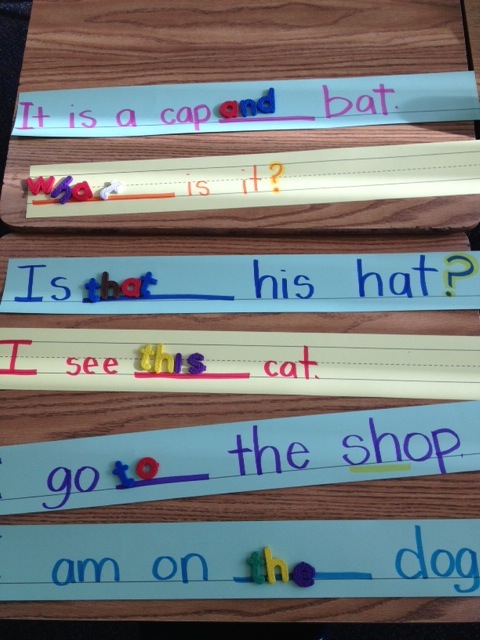
For a larger group, put the sentence strips in a pocket chart with the sight word chopped up into letters.
You could also write the sentence on a magnetic whiteboard and use letter magnets.
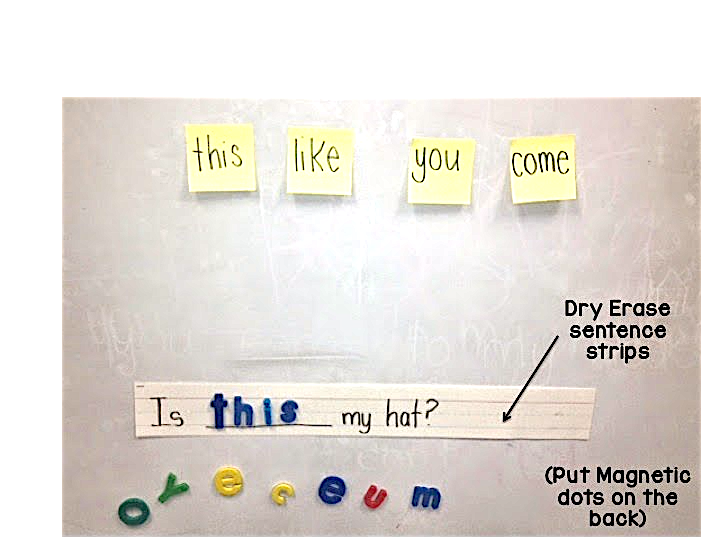
I just want to be clear that this is not used as a decoding activity to guess as a reading strategy. Admittedly, that’s how I used to use these! Since then, I’ve learned that we do not want to put too much focus on using context because it takes away from decoding and leads to bad habits. I think it’s a fine activity to use once words have been taught explicitly. Plus kids see it as a puzzle and it can be fun for them.
Sight Word “Hunts”
Get your students looking for those words! This can be a center, an independent activity, or a warm-up in reading groups. Have your kids look for a certain word in books or big poems.
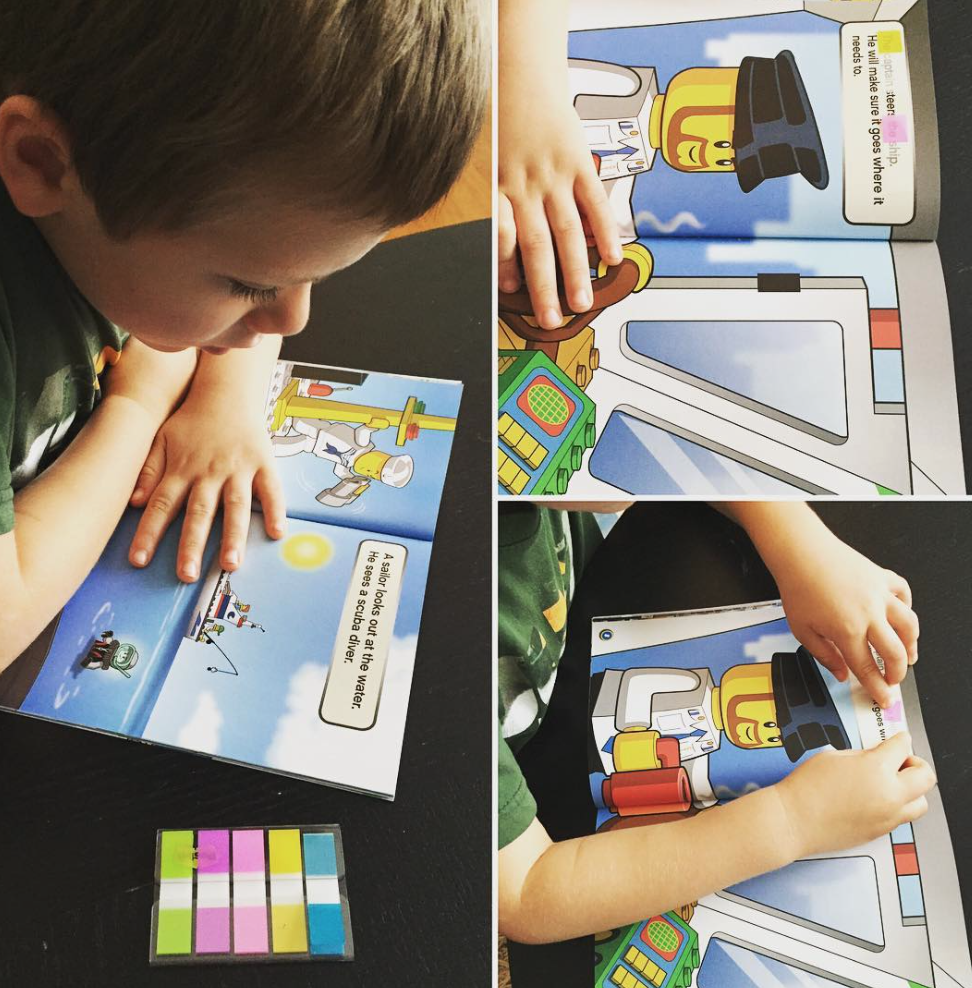
I blogged about this picture already last year. Both of my boys loved to search for words like this. They would focus on one word and try to find it. This was nice in the beginning because they didn’t necessarily have to know the other words on the page yet. They were just looking for that one word. I have several pre-made word hunts that I will show at the end of this post!
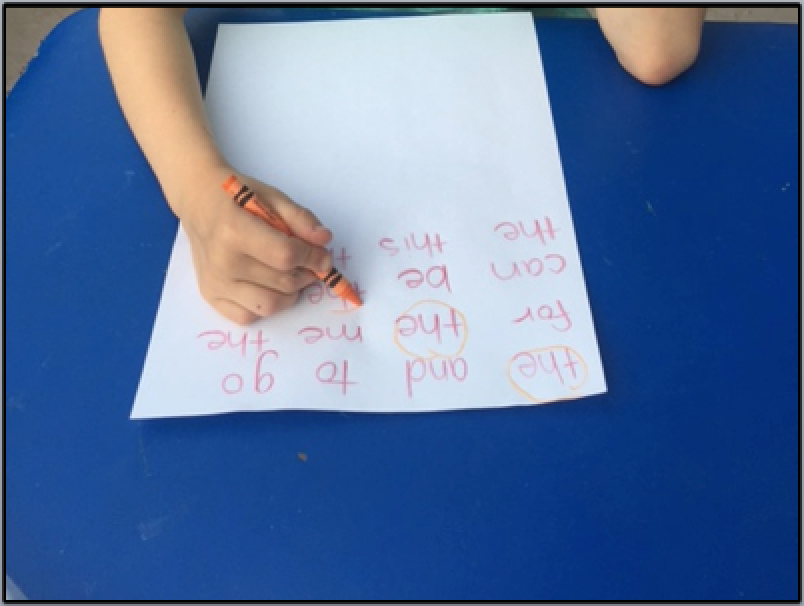
Step 5: Build from Words to Phrases to Sentences
The purpose of mastering high-frequency words is to gain automaticity with these words so that eventually your students will become fluent readers when reading a book or reading passage. BUT sometimes we skip so many steps in between. I know I’ve been guilty of that. Okay, you know that word, sweet! Let’s read this huge passage then. Wait! Rewind. What I mean is, let’s give you those building blocks so that you can read that huge reading passage. Our struggling and beginning readers can be VERY intimidated by a huge reading passage without support. With that said, many of our students learn sight words quickly and are ready for huge passages pretty quickly. I’m more focusing on your students who need a little extra time and guidance.
Sight Word Phrases
We’ve talked about practicing high-frequency words in isolation. Now we’re moving into reading those words in the context of a phrase, sentence, or reading passage. First, you can focus on phrases. These are the common phrases that go together. This is a great way to transition from word to sentence. It’s good for them to see these words in some context. You can actually find fluency phrases all over! Just google and there you will find tons.
I used these after my students had a little practice with the sight words individually. They are phrases, not complete sentences yet. It gives students the chance to practice reading with a little context.
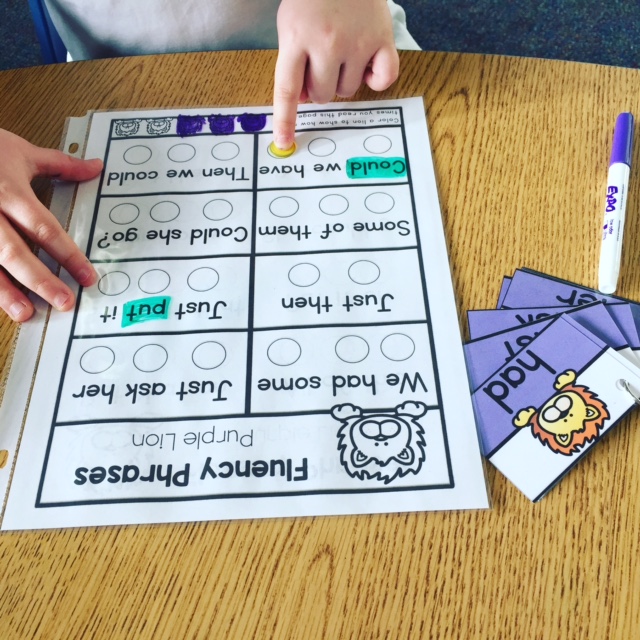
Simple Sentences
Here, I’ve made sentences with a focus on one high-frequency word. This one has the word “like” in each. I made sentences where the student could be successful using their knowledge of the new word, other high-frequency words they’ve already learned, and decodable words. This way, they can practice those words within connected text and be successful!
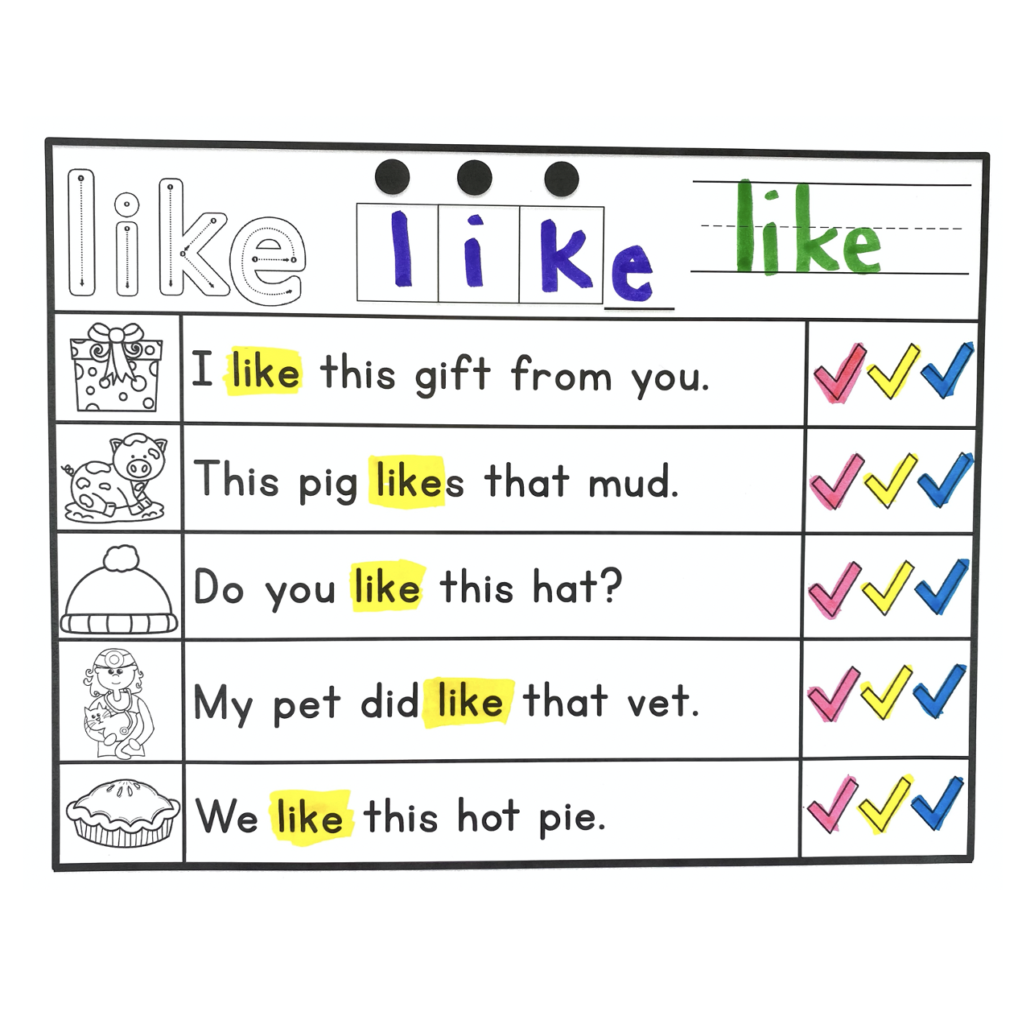
Give your students practice reading those words in context where they can be successful. You can write simple sentences using sentence strips or on chart paper, too!
Sentence Ladders
Once students know a handful of sight words and are even reading those fluency phrases, we get a little excited about throwing them that reading passage or big ol’ book to read. And yes, absolutely that is our goal and many, many kids make that transfer seamlessly and quickly. However, some need a little extra something. I love making Sentence Ladders for my students. It gives them practice with sight words and helps develop fluency because they are rereading words in a sentence over and over.
Which List: Dolch, Fry…or Neither?
Originally, I was using the Dolch list. I created a ton of resources based around this list. I did and do love these resources and found they really helped my students. However, I also felt like these resources didn’t fit into my big picture instructionally. As I learned more about the science of reading, I started to rethink my approach.
Mainly, I was seeing that here I was teaching my kinder students to decode and spell CVC words. For my struggling readers, this was a lot. They would make gains with the right systematic, explicit instruction and were developing an understanding of how words work, at a pace that was appropriate. But then I’d also be like, “Oh yeah and we also have to learn the words “come”, “down”, and “find” because those are on the Dolch kindergarten pre-primer list and that’s just what we do. So, even though it felt like this just didn’t fit with everything else I was doing, I was still doing it. I created the Dolch resources you’ll see below and really tried my best to make them work. I think what I came up with was helpful considering these words were out of place with the rest of the curriculum.
Then I had an epiphany. Wait, I don’t have to teach high frequency words in this order, especially if the science is telling me otherwise. But not just the science. My students were showing me this too. I had already restructured the way I teach high-frequency words. Now I was going to change the order in which I teach them.
I looked over the Dolch and Fry lists and grouped the fully decodable words phonetically. Then I looked at the words that were decodable except for only one or two sound-symbol relationships. I placed those into the groups that made the most sense. Last, I looked at the real odd balls. These are the few words that really are irregular in my mind. I placed those where I felt they made the most sense instructionally.
Once I had a sequence, broke the words up into smaller, more manageable groups. This is one thing I had also done with the dolch list and it really helped my students. They felt more success when they mastered a small set of words (as opposed to looking at this huge list).
Then, I started making activities and teaching resources to go with those words and groups. I made flashcards that mirror the way I teach the words, fluency phrases for each group, sentences focusing on each sight word, word searches, and games.
Sight Word Instruction Resources
I have two different sight word resources. I explained above my evolution with sight word instruction. For this reason, I have two sets of sight word resources: Several resources based around the Dolch list and new resources using the phonetically-grouped list of words. I now use the phonetically-grouped list.
Phonetically-Grouped “Sight Word” Units
To integrate my “sight word” instruction into my existing phonics instruction, I grouped the high-frequency words phonetically. Like my Dolch units, I have one animal to represent each unit and then each unit is further divided into smaller sets, each with a color. In total, there are 6 units. See below for how the words are grouped:

This shows some of Unit 5.
- There are two choices for “flashcards“. One option is color-coordinated with vowels one color and consonants another color. There are also the underlines that represent sounds. (This is my favorite.)The other option is the more cutesie animals.
- There are “fluency phrases” (“printable” option and smaller cards to laminate). Those are just short phrases with high-frequency words from that set.
- Word Searches
- Automaticity games (one for each set): Spin and Read or Roll and Read
- Sentences: Each word has a whole page of 4-5 sentences and then another page that reviews all the words from that set. Option with pictures or without.
- Tracking sheets
There are also directions about how to teach the words using phoneme-grapheme mapping, along with any helpful tips.
I also made Google Slides:
THIS LINK will lead you to the bundle of all 6. If you just want to look at one unit, you will see a link to each individual unit from there.
References
David Kilpatrick’s books: Equipped for Reading Success and The Essentials of Assessing, Preventing, and Overcoming Reading Difficulties.
Louisa Moats: Speech to Print and LETRS books.
A Fresh Look at Phonics by Wiley Blevins.
Rethinking Sight Words. Article by Katharine Pace MilesGregory B. RubinSelenid Gonzalez‐Frey from the International Reading Association Journal.
Additional Posts about Sight Words
For another posts about sight words, click here. There, you will find ideas for the summer AND a printable pack for parents filled with ideas to practice sight words.
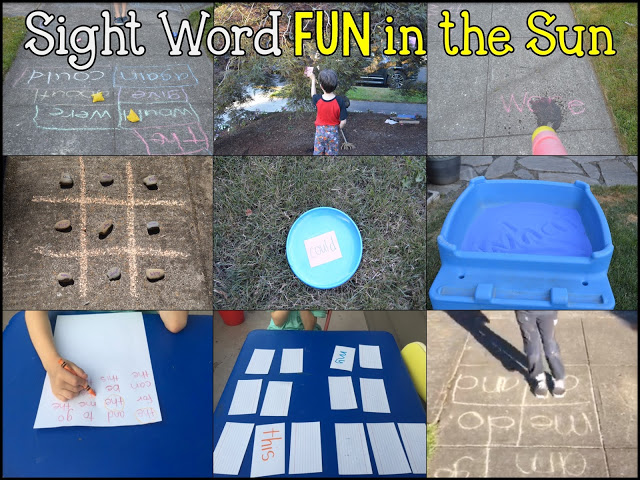
You can find this blog post here.
Like many families this week, your children are heading back to the classroom and coming home with a worksheet or two of homework. (Make that dozens of worksheets for your older kids!) The homework that caught my eye this week is the list of “sight words.” What are sight words? Sight words (high-frequency words, core words or even popcorn words) are the words that are used most often in reading and writing. According to Teach Stix:
In classrooms across America, the development of sight word recognition continues to be a top priority when instructing emerging and beginning readers.
They are called “sight” words because the goal is for your child to recognize these words instantly, at first sight.
Why are Sight Words Important?
Sight words are very important for your child to master because, believe it or not, “sight words account for up to 75% of the words used in beginning children’s printed material”, according to Study to Identify High-Frequency Words in Printed Materials, by D.J. Kear & M.A. Gladhart. There are different sight words for every grade level. Each set of words builds upon the other, meaning that once your child learns the sight words in Kindergarten, he will be expected to still recognize those words as he learns new words in first grade, and so forth.
Many of the over 200 “sight words” do not follow the basic phonics principles, thus they cannot be “sounded out.” Beginning readers need an effective strategy for decoding unknown words, and being familiar with sight words is an effective method. Other benefits of sight words include:
- Sight words promote confidence. Because the first 100 sight words represent over 50% of English text, a child who has mastered the list of sight words can already recognize at least half of a sentence. If your child begins to read a book and can already recognize the words, chances are he won’t feel discouraged and put the book down, rather he’ll have more confidence to read it all the way through. And, choose another!
- Sight words help promote reading comprehension. When your child opens her book for the first time, instead of trying to decipher what ALL of the words mean, she can shift her attention to focus on those words she is not familiar with. She will already know at least half of the words, so focusing on the other half helps strengthen her understanding of the text.
- Sight words provide clues to the context of the text. If your child is familiar with the sight words, she may be able to decode the meaning of the paragraph or sentence by reading the sight words. And, if a picture accompanies the text, your child may be able to determine what the story is about and come away with a few new words under her belt.
How to Practice Sight Words
You will want to become familiar with all of the sight words for each grade. Both the Dolch List of Basic Sight Words and Fry’s 300 Instant Sight Words, each of which can be downloaded from the Literacy and Information Communication System (LINCS) website. The key to mastering the list of sight words? Practice and repeat! The more opportunity your child has to become familiar with these words, the better. Of course, you’ll see sight words come home in the homework folder, or you may even be asked by the teacher to use flashcards, but there are many FUN activities and games that you can do together to help promote learning of the sight words.
Educational website, Ed Helper has an extensive collection of printables and worksheets designed to help kids conquer their list of sight words. Even Pinterest has jumped aboard with creative ideas to help your child work on sight words. There is an entire Pinterest site dedicated to sight word activities for your kids! Think Skittles, snowballs, chalkboards…the choices are endless! Take a look!
Creative Ways to Conquer Sight Words. Pinned Image from teacherspayteachers.com
Sight words help your child build a foundation for reading comprehension and fluency. How about using online tools to help perfect those words? Most kids will welcome the chance to “play” online, even if it is educational. Our new Bitsboard app is a great way to target certain sounds and sight words in an engaging way. Enjoy!
Language Development
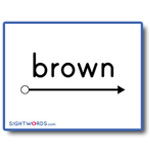
Overview
Learn the history behind Dolch and Fry sight words, and why they are important in developing fluent readers.
More

Lessons
Follow the sight words teaching techniques. Learn research-validated and classroom-proven ways to introduce words, reinforce learning, and correct mistakes.
More
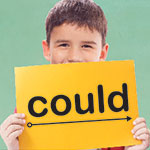
Flash Cards
Print your own sight words flash cards. Create a set of Dolch or Fry sight words flash cards, or use your own custom set of words.
More
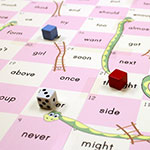
Games
Play sight words games. Make games that create fun opportunities for repetition and reinforcement of the lessons.
More
- Overview
- What Are Sight Words?
- Types of Sight Words
- When to Start
- Scaling & Scaffolding
- Research
- Questions and Answers
1. Overview
Sight words instruction is an excellent supplement to phonics instruction. Phonics is a method for learning to read in general, while sight words instruction increases a child’s familiarity with the high frequency words he will encounter most often.
The best way to learn sight words is through lots and lots of repetition, in the form of flashcard exercises and word-focused games.
↑ Top
2. What Are Sight Words?
Sight words are words that should be memorized to help a child learn to read and write. Learning sight words allows a child to recognize these words at a glance — on sight — without needing to break the words down into their individual letters and is the way strong readers recognize most words. Knowing common, or high frequency, words by sight makes reading easier and faster, because the reader does not need to stop to try and sound out each individual word, letter by letter.
Sight Words are memorized so that a child can recognize commonly used or phonetically irregular words at a glance, without needing to go letter-by-letter.
Other terms used to describe sight words include: service words, instant words (because you should recognize them instantly), snap words (because you should know them in a snap), and high frequency words. You will also hear them referred to as Dolch words or Fry words, the two most commonly used sight words lists.
Sight words are the glue that holds sentences together.
These pages contain resources to teach sight words, including: sight words flash cards, lessons, and games. If you are new to sight words, start with the teaching strategies to get a road map for teaching the material, showing you how to sequence the lessons and activities.
↑ Top
3. Types of Sight Words
Sight words fall into two categories:
- Frequently Used Words — Words that occur commonly in the English language, such as it, can, and will. Memorizing these words makes reading much easier and smoother, because the child already recognizes most of the words and can concentrate their efforts on new words. For example, knowing just the Dolch Sight Words would enable you to read about 50% of a newspaper or 80% of a children’s book.
- Non-Phonetic Words — Words that cannot be decoded phonetically, such as buy, talk, or come. Memorizing these words with unnatural spellings and pronunciations teaches not only these words but also helps the reader recognize similar words, such as guy, walk, or some.
There are several lists of sight words that are in common use, such as Dolch, Fry, Top 150, and Core Curriculum. There is a great deal of overlap among the lists, but the Dolch sight word list is the most popular and widely used.
3.1 Dolch Sight Words
The Dolch Sight Words list is the most commonly used set of sight words. Educator Dr. Edward William Dolch developed the list in the 1930s-40s by studying the most frequently occurring words in children’s books of that era. The list contains 220 “service words” plus 95 high-frequency nouns. The Dolch sight words comprise 80% of the words you would find in a typical children’s book and 50% of the words found in writing for adults. Once a child knows the Dolch words, it makes reading much easier, because the child can then focus his or her attention on the remaining words.
More
3.2 Fry Sight Words
The Fry Sight Words list is a more modern list of words, and was extended to capture the most common 1,000 words. Dr. Edward Fry developed this expanded list in the 1950s (and updated it in 1980), based on the most common words to appear in reading materials used in Grades 3-9. Learning all 1,000 words in the Fry sight word list would equip a child to read about 90% of the words in a typical book, newspaper, or website.
More
3.3 Top 150 Written Words
The Top 150 Written Words is the newest of the word lists featured on our site, and is commonly used by people who are learning to read English as a non-native language. This list consists of the 150 words that occur most frequently in printed English, according to the Word Frequency Book. This list is recommended by Sally E. Shaywitz, M.D., Professor of Learning Development at Yale University’s School of Medicine.
More
3.4 Other Sight Words Lists
There are many newer variations, such as the Common Core sight words, that tweak the Dolch and Fry sight words lists to find the combination of words that is the most beneficial for reading development. Many teachers take existing sight word lists and customize them, adding words from their own classroom lessons.
↑ Top
4. When to Start Teaching Sight Words
Before a child starts learning sight words, it is important that he/she be able to recognize and name all the lower-case letters of the alphabet. When prompted with a letter, the child should be able to name the letter quickly and confidently. Note that, different from learning phonics, the child does not need to know the letters’ sounds.
Before starting sight words, a child needs to be able to recognize and name all the lower-case letters of the alphabet.
If a student’s knowledge of letter names is still shaky, it is important to spend time practicing this skill before jumping into sight words. Having a solid foundation in the ability to instantly recognize and name the alphabet letters will make teaching sight words easier and more meaningful for the child.
Go to our Lessons for proven strategies on how to teach and practice sight words with your child.
↑ Top
5. Scaling & Scaffolding
Every child is unique and will learn sight words at a different rate. A teacher may have a wide range of skill levels in the same classroom. Many of our sight words games can be adjusted to suit different skill levels.
Many of our activity pages feature recommendations for adjusting the game to the needs of your particular child or classroom:
- Confidence Builders suggest ways to simplify a sight words game for a struggling student.
- Extensions offer tips for a child who loves playing a particular game but needs to be challenged more.
- Variations suggest ways to change up the game a little, by tailoring it to a child’s special interests or making it “portable.”
- Small Group Adaptations offer ideas for scaling up from an individual child to a small group (2-5 children), ensuring that every child is engaged and learning.
↑ Top
6. Research
Our sight words teaching techniques are based not only on classroom experience but also on the latest in child literacy research. Here is a bibliography of some of the research supporting our approach to sight words instruction:
- Ceprano, M. A. “A review of selected research on methods of teaching sight words.” The Reading Teacher 35:3 (1981): 314-322.
- Ehri, Linnea C. “Grapheme–Phoneme Knowledge Is Essential for Learning to Read Words in English.” Word Recognition in Beginning Literacy. Mahwah, NJ: L. Erlbaum Associates, 1998.
- Enfield, Mary Lee, and Victoria Greene. Project Read. www.projectread.com. 1969.
- Gillingham, Anna, and Bessie W. Stillman. The Gillingham Manual: Remedial Training for Students with Specific Disability in Reading, Spelling, and Penmanship, 8th edition. Cambridge, MA: Educators Publishing Service, 2014.
- Nist, Lindsay, and Laurice M. Joseph. “Effectiveness and Efficiency of Flashcard Drill Instructional Methods on Urban First-Graders’ Word Recognition, Acquisition, Maintenance, and Generalization.” School Psychology Review 37:3 (Fall 2008): 294-308.
- Shaywitz, Sally E. Overcoming Dyslexia: A New and Complete Science-Based Program for Reading Problems at Any Level. New York: Alfred A. Knopf, 2003.
- Stoner, J.C. “Teaching at-risk students to read using specialized techniques in the regular classroom.” Reading and Writing: An Interdisciplinary Journal 3 (1991).
- Wilson, Barbara A. “The Wilson Reading Method.” Learning Disabilities Journal 8:1 (February 1998): 12-13.
- Wilson, Barbara A. Wilson Reading System. Millbury, MA: Wilson Language Training, 1988.
↑ Top
Leave a Reply
Recent Blog Posts

Case Wars: Upper vs. Lower Case Letters
September 27, 2016
Some of our visitors ask us why all our materials are printed in lower-case letters as opposed to upper-case letters. We know that many preschool and kindergarten teachers focus on teaching upper-case letters first. The ability to recognize lower-case letters … Continued

Is It Dyslexia?
August 29, 2016
We sometimes get questions from SightWords.com visitors who are concerned that their child or grandchild may have a learning disability. Of particular concern is the possibility that their child might have dyslexia. Many people assume that dyslexia is a visual … Continued

SightWords.com at the Southeast Homeschool Expo
August 10, 2016
On July 29th and 30th, board members of the Georgia Preschool Association met at the Cobb Galleria Centre just outside Atlanta to attend the Southeast Homeschool Expo, a convention for homeschooling families and resource providers from across the Southeastern U.S. … Continued
© 2023 Sight Words: Teach Your Child to Read


